Importance of Personality and Development Theories for Counsellors
VerifiedAdded on 2023/01/12
|35
|7513
|1
AI Summary
This content discusses the importance of personality and development theories for counsellors and how it can benefit their practice. It explores the influence of nature and nurture factors on development and discusses the role of the psychoanalytic/psychodynamic approach in personality development.
Contribute Materials
Your contribution can guide someone’s learning journey. Share your
documents today.
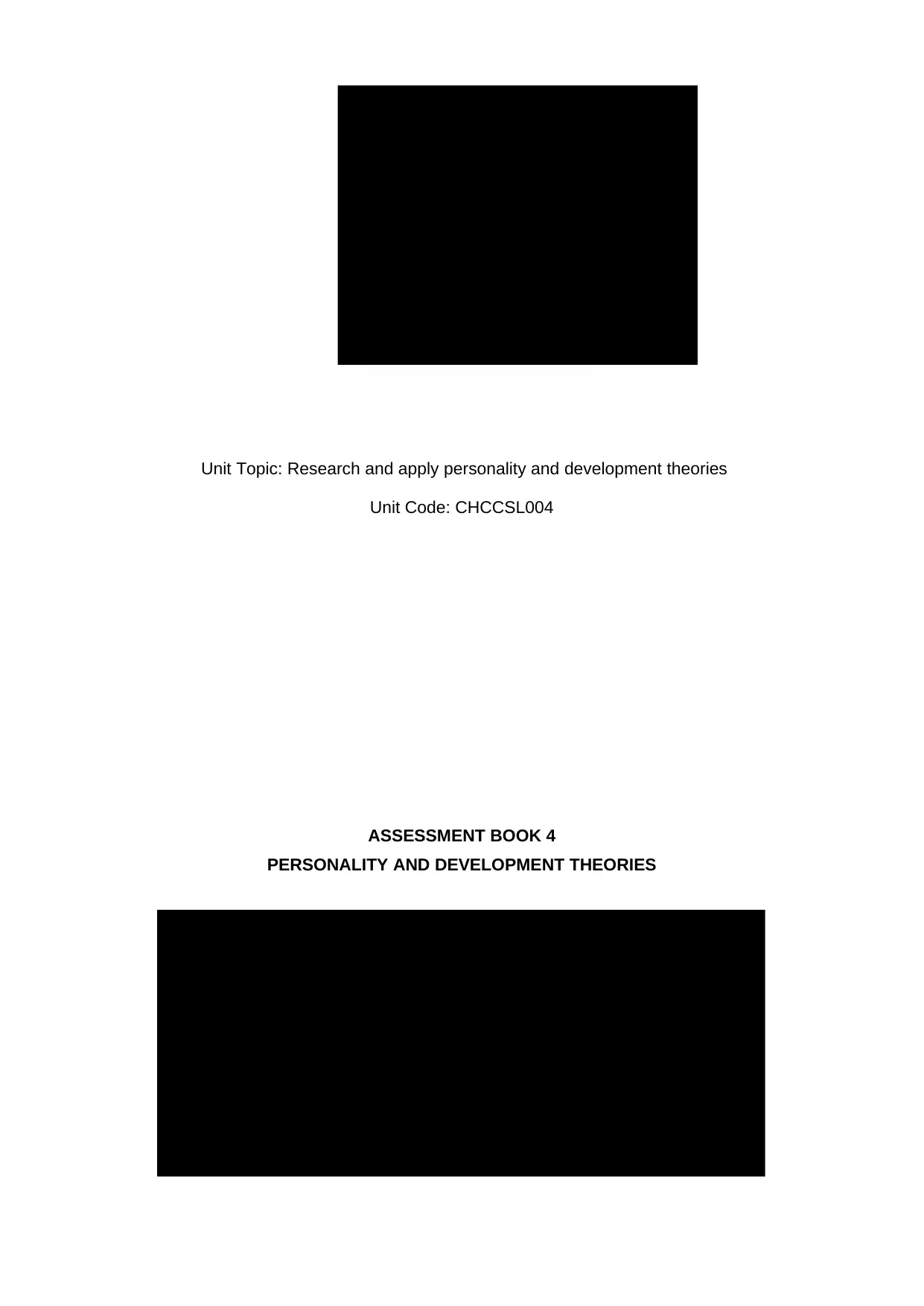
Unit Topic: Research and apply personality and development theories
Unit Code: CHCCSL004
ASSESSMENT BOOK 4
PERSONALITY AND DEVELOPMENT THEORIES
Unit Code: CHCCSL004
ASSESSMENT BOOK 4
PERSONALITY AND DEVELOPMENT THEORIES
Secure Best Marks with AI Grader
Need help grading? Try our AI Grader for instant feedback on your assignments.

This book is protected by copyright and may not be reproduced or copied either in part or in
whole nor used for financial gain without the express approval in writing of the owner
(Australian Institute of Professional Counsellors Pty Ltd ATF AIPC Trust ACN 077 738 035)
of the copyright.
whole nor used for financial gain without the express approval in writing of the owner
(Australian Institute of Professional Counsellors Pty Ltd ATF AIPC Trust ACN 077 738 035)
of the copyright.
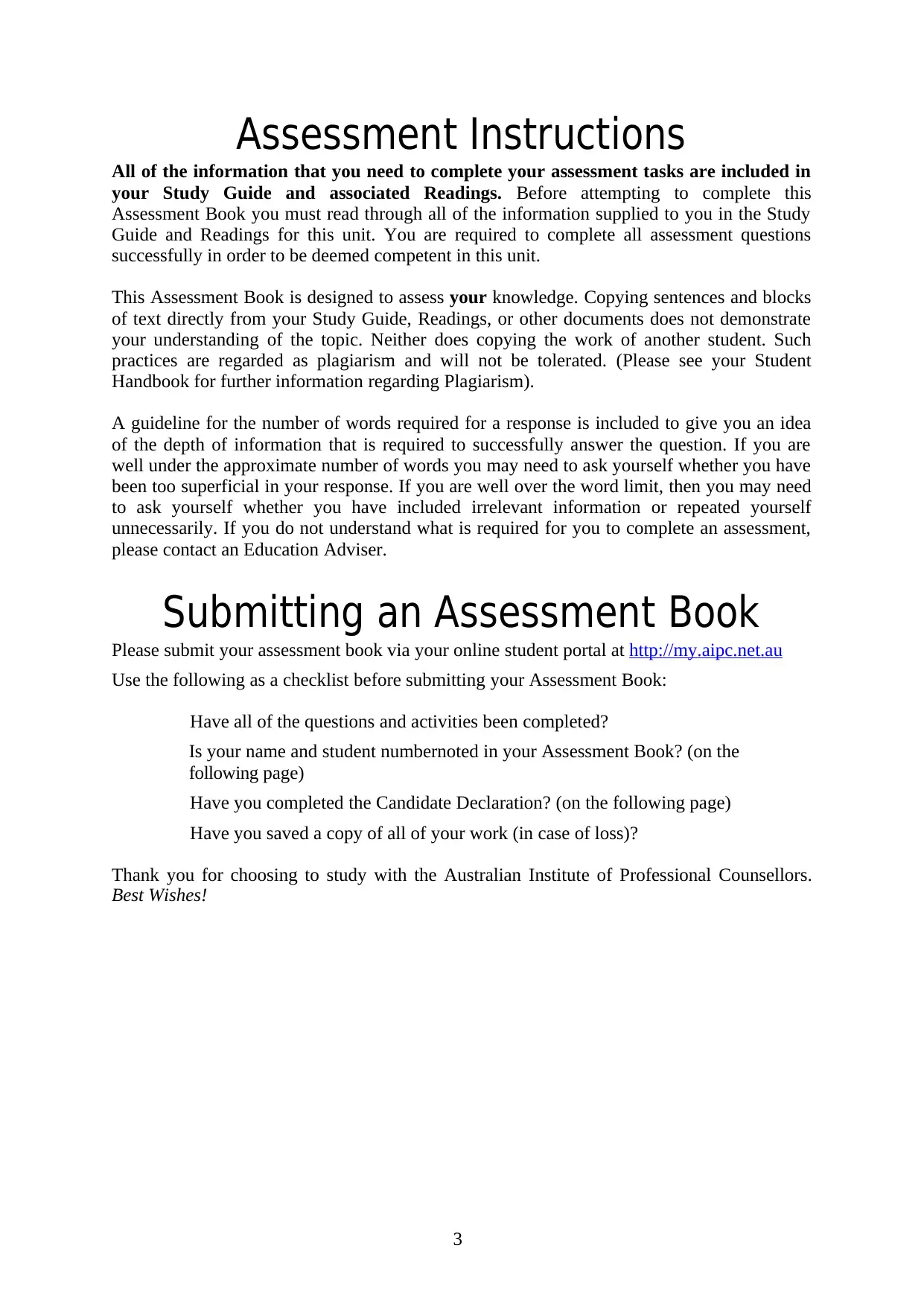
3
Assessment Instructions
All of the information that you need to complete your assessment tasks are included in
your Study Guide and associated Readings. Before attempting to complete this
Assessment Book you must read through all of the information supplied to you in the Study
Guide and Readings for this unit. You are required to complete all assessment questions
successfully in order to be deemed competent in this unit.
This Assessment Book is designed to assess your knowledge. Copying sentences and blocks
of text directly from your Study Guide, Readings, or other documents does not demonstrate
your understanding of the topic. Neither does copying the work of another student. Such
practices are regarded as plagiarism and will not be tolerated. (Please see your Student
Handbook for further information regarding Plagiarism).
A guideline for the number of words required for a response is included to give you an idea
of the depth of information that is required to successfully answer the question. If you are
well under the approximate number of words you may need to ask yourself whether you have
been too superficial in your response. If you are well over the word limit, then you may need
to ask yourself whether you have included irrelevant information or repeated yourself
unnecessarily. If you do not understand what is required for you to complete an assessment,
please contact an Education Adviser.
Submitting an Assessment Book
Please submit your assessment book via your online student portal at http://my.aipc.net.au
Use the following as a checklist before submitting your Assessment Book:
Have all of the questions and activities been completed?
Is your name and student numbernoted in your Assessment Book? (on the
following page)
Have you completed the Candidate Declaration? (on the following page)
Have you saved a copy of all of your work (in case of loss)?
Thank you for choosing to study with the Australian Institute of Professional Counsellors.
Best Wishes!
Assessment Instructions
All of the information that you need to complete your assessment tasks are included in
your Study Guide and associated Readings. Before attempting to complete this
Assessment Book you must read through all of the information supplied to you in the Study
Guide and Readings for this unit. You are required to complete all assessment questions
successfully in order to be deemed competent in this unit.
This Assessment Book is designed to assess your knowledge. Copying sentences and blocks
of text directly from your Study Guide, Readings, or other documents does not demonstrate
your understanding of the topic. Neither does copying the work of another student. Such
practices are regarded as plagiarism and will not be tolerated. (Please see your Student
Handbook for further information regarding Plagiarism).
A guideline for the number of words required for a response is included to give you an idea
of the depth of information that is required to successfully answer the question. If you are
well under the approximate number of words you may need to ask yourself whether you have
been too superficial in your response. If you are well over the word limit, then you may need
to ask yourself whether you have included irrelevant information or repeated yourself
unnecessarily. If you do not understand what is required for you to complete an assessment,
please contact an Education Adviser.
Submitting an Assessment Book
Please submit your assessment book via your online student portal at http://my.aipc.net.au
Use the following as a checklist before submitting your Assessment Book:
Have all of the questions and activities been completed?
Is your name and student numbernoted in your Assessment Book? (on the
following page)
Have you completed the Candidate Declaration? (on the following page)
Have you saved a copy of all of your work (in case of loss)?
Thank you for choosing to study with the Australian Institute of Professional Counsellors.
Best Wishes!
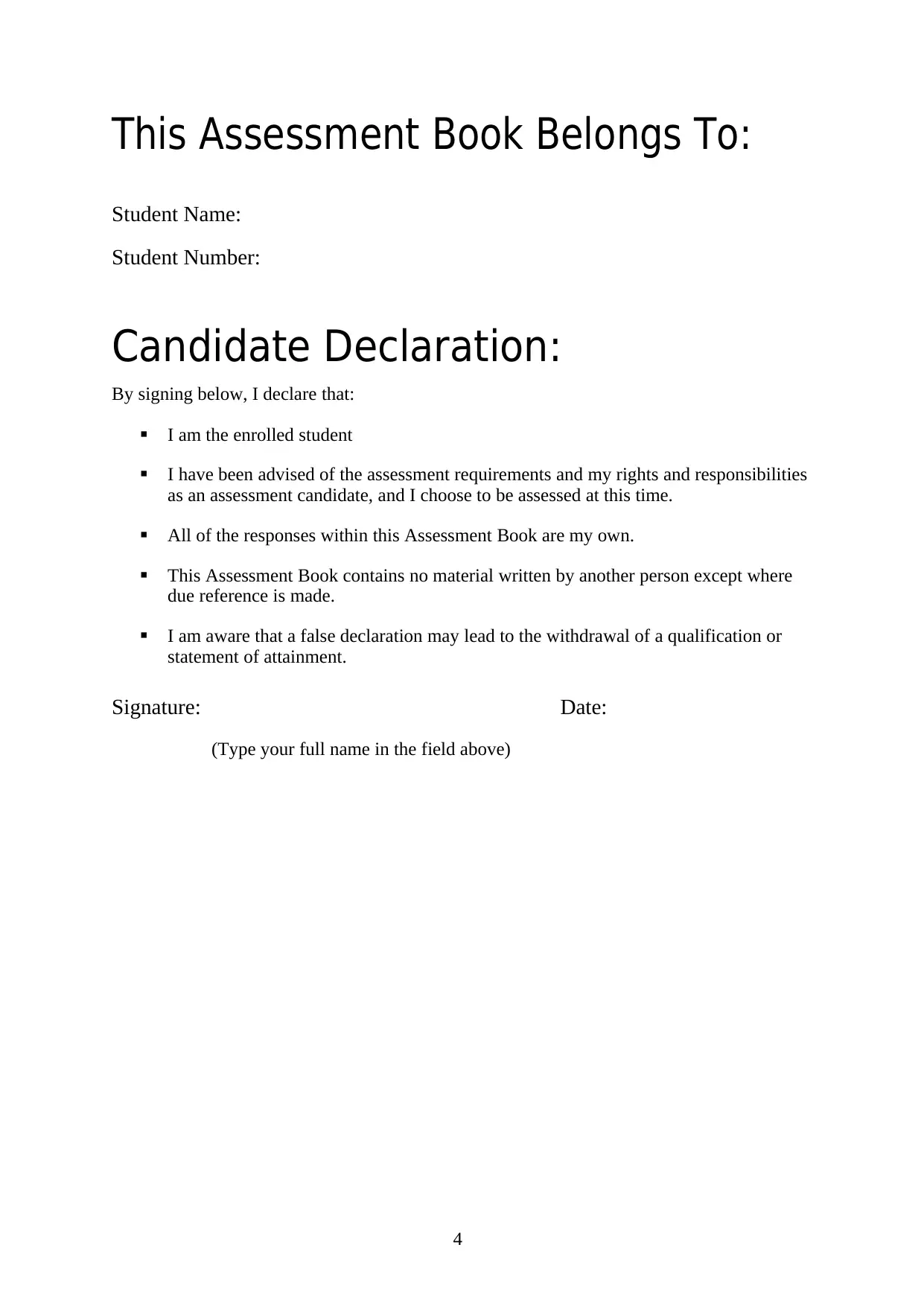
4
This Assessment Book Belongs To:
Student Name:
Student Number:
Candidate Declaration:
By signing below, I declare that:
I am the enrolled student
I have been advised of the assessment requirements and my rights and responsibilities
as an assessment candidate, and I choose to be assessed at this time.
All of the responses within this Assessment Book are my own.
This Assessment Book contains no material written by another person except where
due reference is made.
I am aware that a false declaration may lead to the withdrawal of a qualification or
statement of attainment.
Signature: Date:
(Type your full name in the field above)
This Assessment Book Belongs To:
Student Name:
Student Number:
Candidate Declaration:
By signing below, I declare that:
I am the enrolled student
I have been advised of the assessment requirements and my rights and responsibilities
as an assessment candidate, and I choose to be assessed at this time.
All of the responses within this Assessment Book are my own.
This Assessment Book contains no material written by another person except where
due reference is made.
I am aware that a false declaration may lead to the withdrawal of a qualification or
statement of attainment.
Signature: Date:
(Type your full name in the field above)
Secure Best Marks with AI Grader
Need help grading? Try our AI Grader for instant feedback on your assignments.
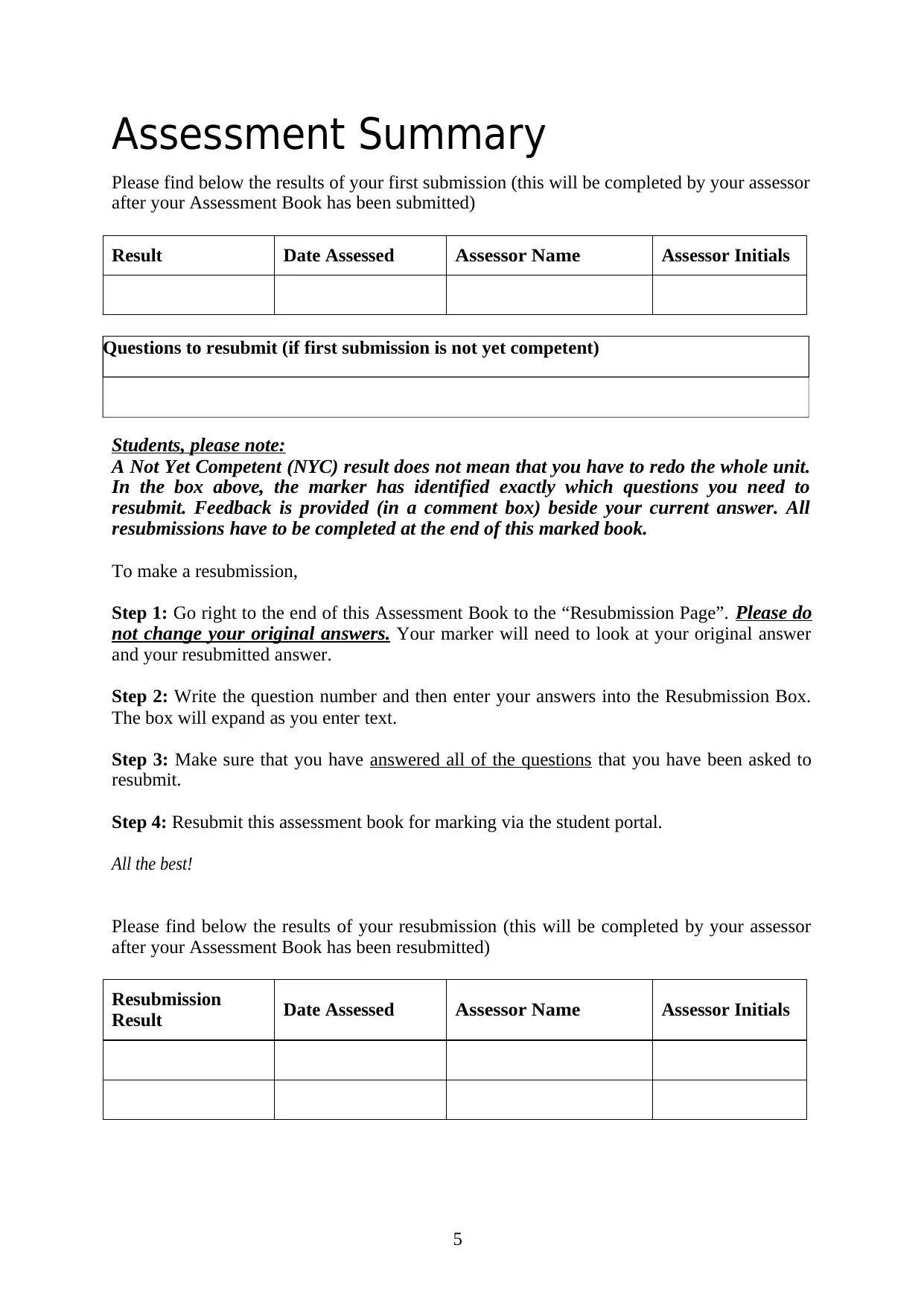
5
Questions to resubmit (if first submission is not yet competent)
Assessment Summary
Please find below the results of your first submission (this will be completed by your assessor
after your Assessment Book has been submitted)
Result Date Assessed Assessor Name Assessor Initials
Students, please note:
A Not Yet Competent (NYC) result does not mean that you have to redo the whole unit.
In the box above, the marker has identified exactly which questions you need to
resubmit. Feedback is provided (in a comment box) beside your current answer. All
resubmissions have to be completed at the end of this marked book.
To make a resubmission,
Step 1: Go right to the end of this Assessment Book to the “Resubmission Page”. Please do
not change your original answers. Your marker will need to look at your original answer
and your resubmitted answer.
Step 2: Write the question number and then enter your answers into the Resubmission Box.
The box will expand as you enter text.
Step 3: Make sure that you have answered all of the questions that you have been asked to
resubmit.
Step 4: Resubmit this assessment book for marking via the student portal.
All the best!
Please find below the results of your resubmission (this will be completed by your assessor
after your Assessment Book has been resubmitted)
Resubmission
Result Date Assessed Assessor Name Assessor Initials
Questions to resubmit (if first submission is not yet competent)
Assessment Summary
Please find below the results of your first submission (this will be completed by your assessor
after your Assessment Book has been submitted)
Result Date Assessed Assessor Name Assessor Initials
Students, please note:
A Not Yet Competent (NYC) result does not mean that you have to redo the whole unit.
In the box above, the marker has identified exactly which questions you need to
resubmit. Feedback is provided (in a comment box) beside your current answer. All
resubmissions have to be completed at the end of this marked book.
To make a resubmission,
Step 1: Go right to the end of this Assessment Book to the “Resubmission Page”. Please do
not change your original answers. Your marker will need to look at your original answer
and your resubmitted answer.
Step 2: Write the question number and then enter your answers into the Resubmission Box.
The box will expand as you enter text.
Step 3: Make sure that you have answered all of the questions that you have been asked to
resubmit.
Step 4: Resubmit this assessment book for marking via the student portal.
All the best!
Please find below the results of your resubmission (this will be completed by your assessor
after your Assessment Book has been resubmitted)
Resubmission
Result Date Assessed Assessor Name Assessor Initials

6
Section 1
PERSONALITY AND DEVELOPMENT: THEORY AND
PRACTICE
Why is it important for counsellors to learn about theories of personality and lifespan
development? Hint: Consider what this understanding can provide counsellors with
that would be useful within counselling. (Your response should be no more than 75
words)
It is highly important for the counselors to learn about theories of motivation as it works
as the road map the counselors which provide them direction to serve their respective
client in appropriate format. Knowledge on these theories that is personality and
lifespan development helps a counselor in making effective integration between
external as well as self knowledge which ultimately contributes in serving the
customers in best possible manner.
Theories of personality and human development
Select whether the following statements are True or False.
a) Many of the issues that bring clients to counselling are related to changes that
occur across the lifespan.
True False
b) The term physical development is used to refer to things such as the biological
growth of the body, the functioning of physiological systems, physical signs of
aging, and changes in motor abilities.
True False
c) The term psychosocial development is used to refer to changes and continuities in
things such as a person’s perception, language, learning, memory, and problem
solving processes.
True False
d) Theories of human development generally attempt to describe, explain, and
predict the changes that may occur across the lifespan in a particular domain
Nature versus
nurture
True False
Historically, some theorists believed that ‘nature’ factors such as biology and genetics
were the drivers of personality and development, while other theorists assumed that
‘nurture’ factors such as education, culture, and living environment were more
important. What is the current prevailing view of the influence of nature and nurture
factors on development? (Your response should be no more than 100 words)
Section 1
PERSONALITY AND DEVELOPMENT: THEORY AND
PRACTICE
Why is it important for counsellors to learn about theories of personality and lifespan
development? Hint: Consider what this understanding can provide counsellors with
that would be useful within counselling. (Your response should be no more than 75
words)
It is highly important for the counselors to learn about theories of motivation as it works
as the road map the counselors which provide them direction to serve their respective
client in appropriate format. Knowledge on these theories that is personality and
lifespan development helps a counselor in making effective integration between
external as well as self knowledge which ultimately contributes in serving the
customers in best possible manner.
Theories of personality and human development
Select whether the following statements are True or False.
a) Many of the issues that bring clients to counselling are related to changes that
occur across the lifespan.
True False
b) The term physical development is used to refer to things such as the biological
growth of the body, the functioning of physiological systems, physical signs of
aging, and changes in motor abilities.
True False
c) The term psychosocial development is used to refer to changes and continuities in
things such as a person’s perception, language, learning, memory, and problem
solving processes.
True False
d) Theories of human development generally attempt to describe, explain, and
predict the changes that may occur across the lifespan in a particular domain
Nature versus
nurture
True False
Historically, some theorists believed that ‘nature’ factors such as biology and genetics
were the drivers of personality and development, while other theorists assumed that
‘nurture’ factors such as education, culture, and living environment were more
important. What is the current prevailing view of the influence of nature and nurture
factors on development? (Your response should be no more than 100 words)

7
At current level nurture is placing more influential role in the growth or development of
the individual which directly influencing overall grooming of the individuals whereas
if it is talked about nature then it can also be said that it includes inherent genes of the
individuals which influences their overall growth. By analyzing overall influence of
the both the nature and nurture it can be said that both the terms has their own
influence over the development of individual. By evaluating current scenario, it can be
said that factors associated with the nurture are more influential on the overall
development as it includes external factors.
Do people ‘inherit’ psychological disorders? Explain. (Your total response should be no
more than 100 words)
Yes, people have inherited psychological disorder which simply means that they have received
this disorder from their ancestors in the form of gene. It can be said that if any person has family
medical history of psychological disorders then there are probable chances that this person would
definitely have higher proportion of the having the same disease. This is acknowledged as the main
risky factor that could affect overall growth of the individual and makes him suffer from psychological
disorder to raising issues in their life and external market influences.
At current level nurture is placing more influential role in the growth or development of
the individual which directly influencing overall grooming of the individuals whereas
if it is talked about nature then it can also be said that it includes inherent genes of the
individuals which influences their overall growth. By analyzing overall influence of
the both the nature and nurture it can be said that both the terms has their own
influence over the development of individual. By evaluating current scenario, it can be
said that factors associated with the nurture are more influential on the overall
development as it includes external factors.
Do people ‘inherit’ psychological disorders? Explain. (Your total response should be no
more than 100 words)
Yes, people have inherited psychological disorder which simply means that they have received
this disorder from their ancestors in the form of gene. It can be said that if any person has family
medical history of psychological disorders then there are probable chances that this person would
definitely have higher proportion of the having the same disease. This is acknowledged as the main
risky factor that could affect overall growth of the individual and makes him suffer from psychological
disorder to raising issues in their life and external market influences.
Paraphrase This Document
Need a fresh take? Get an instant paraphrase of this document with our AI Paraphraser

Thomas has been referred to your counselling agency for depression and alcohol
abuse. He was assessed by the intake team who have provided you with the
following details regarding his history:
Client history:
Thomas was born in regional QLD to a single mother. His mother had depression
and abused prescription drugs; she died of an overdose when Thomas was 7 years
old. After this, Thomas lived with various relatives and foster parents. There is no
disclosed history of abuse. Thomas attended the local public high school and
obtained low to average grades. He discontinued schooling after Year 9 and left
home to live independently at age 15. He worked sporadically as a labourer until a
workplace injury
12 months ago rendered him incapacitated. He is now on a temporary disability
pension. He is overweight and is being treated for Type II diabetes.
Thomas is married with two children aged 5 and 9. He described his wife as loving
and supportive. He has limited social support outside of his immediate family and
has no active interests or hobbies. Thomas has had bouts of depression since age
21, but his symptoms have worsened since being out of work. His wife is
concerned about his mood and recent episodes of severe binge drinking – up to a
8
List three genetic (i.e., ‘nature’) factors that counsellors should consider about their
clients. (Your total response should be no more than 30 words)
Medical history
Biological components
Parenting style
List three environmental (i.e., ‘nurture’) factors that counsellors should consider about
their clients. (Your total response should be no more than 30 words)
Socio economic factors
Risk factors
External environmental factor
Consider the following case scenario in relation to the issues of nature and nurture.
a) List the nature (biological and genetic) factors that have influenced Thomas’
current presenting problems (depression and alcohol abuse). (Your response
should be no more than 50 words)
According to the given case study Biological factors which have influenced
Thomas is higher genetic issue of depression that has been inherent in this person
since the birth as his mother was also going through the depression. Loneliness
has influenced the same person to develop their interest towards the drinking.
b) List the nurture (environmental) factors that have influenced Thomas’ current
presenting problems (depression and alcohol abuse). (Your response should be no
more than 50 words)
It can be that environmental factors and external situation of the Thomas’ life that injury
at workplace, non corporation of the relative etc. have increased chances of depression in Thomas life
and influenced him to come forward towards alcohol abuse.
abuse. He was assessed by the intake team who have provided you with the
following details regarding his history:
Client history:
Thomas was born in regional QLD to a single mother. His mother had depression
and abused prescription drugs; she died of an overdose when Thomas was 7 years
old. After this, Thomas lived with various relatives and foster parents. There is no
disclosed history of abuse. Thomas attended the local public high school and
obtained low to average grades. He discontinued schooling after Year 9 and left
home to live independently at age 15. He worked sporadically as a labourer until a
workplace injury
12 months ago rendered him incapacitated. He is now on a temporary disability
pension. He is overweight and is being treated for Type II diabetes.
Thomas is married with two children aged 5 and 9. He described his wife as loving
and supportive. He has limited social support outside of his immediate family and
has no active interests or hobbies. Thomas has had bouts of depression since age
21, but his symptoms have worsened since being out of work. His wife is
concerned about his mood and recent episodes of severe binge drinking – up to a
8
List three genetic (i.e., ‘nature’) factors that counsellors should consider about their
clients. (Your total response should be no more than 30 words)
Medical history
Biological components
Parenting style
List three environmental (i.e., ‘nurture’) factors that counsellors should consider about
their clients. (Your total response should be no more than 30 words)
Socio economic factors
Risk factors
External environmental factor
Consider the following case scenario in relation to the issues of nature and nurture.
a) List the nature (biological and genetic) factors that have influenced Thomas’
current presenting problems (depression and alcohol abuse). (Your response
should be no more than 50 words)
According to the given case study Biological factors which have influenced
Thomas is higher genetic issue of depression that has been inherent in this person
since the birth as his mother was also going through the depression. Loneliness
has influenced the same person to develop their interest towards the drinking.
b) List the nurture (environmental) factors that have influenced Thomas’ current
presenting problems (depression and alcohol abuse). (Your response should be no
more than 50 words)
It can be that environmental factors and external situation of the Thomas’ life that injury
at workplace, non corporation of the relative etc. have increased chances of depression in Thomas life
and influenced him to come forward towards alcohol abuse.
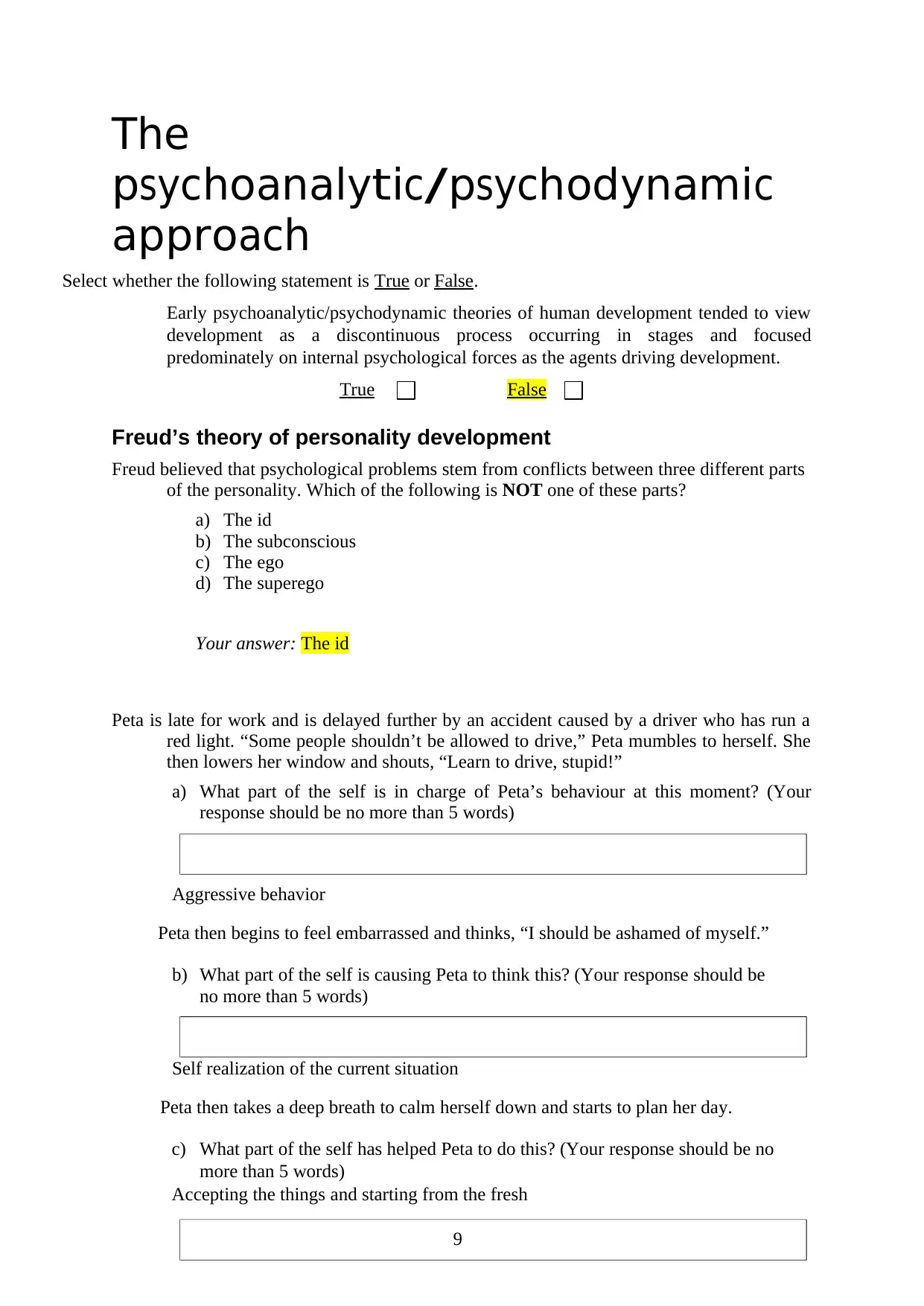
9
T he
p s yc ho an al yt ic / ps yc ho d ynam i c
ap p ro ac h
Select whether the following statement is True or False.
Early psychoanalytic/psychodynamic theories of human development tended to view
development as a discontinuous process occurring in stages and focused
predominately on internal psychological forces as the agents driving development.
True False
Freud’s theory of personality development
Freud believed that psychological problems stem from conflicts between three different parts
of the personality. Which of the following is NOT one of these parts?
a) The id
b) The subconscious
c) The ego
d) The superego
Your answer: The id
Peta is late for work and is delayed further by an accident caused by a driver who has run a
red light. “Some people shouldn’t be allowed to drive,” Peta mumbles to herself. She
then lowers her window and shouts, “Learn to drive, stupid!”
a) What part of the self is in charge of Peta’s behaviour at this moment? (Your
response should be no more than 5 words)
Aggressive behavior
Peta then begins to feel embarrassed and thinks, “I should be ashamed of myself.”
b) What part of the self is causing Peta to think this? (Your response should be
no more than 5 words)
Self realization of the current situation
Peta then takes a deep breath to calm herself down and starts to plan her day.
c) What part of the self has helped Peta to do this? (Your response should be no
more than 5 words)
Accepting the things and starting from the fresh
T he
p s yc ho an al yt ic / ps yc ho d ynam i c
ap p ro ac h
Select whether the following statement is True or False.
Early psychoanalytic/psychodynamic theories of human development tended to view
development as a discontinuous process occurring in stages and focused
predominately on internal psychological forces as the agents driving development.
True False
Freud’s theory of personality development
Freud believed that psychological problems stem from conflicts between three different parts
of the personality. Which of the following is NOT one of these parts?
a) The id
b) The subconscious
c) The ego
d) The superego
Your answer: The id
Peta is late for work and is delayed further by an accident caused by a driver who has run a
red light. “Some people shouldn’t be allowed to drive,” Peta mumbles to herself. She
then lowers her window and shouts, “Learn to drive, stupid!”
a) What part of the self is in charge of Peta’s behaviour at this moment? (Your
response should be no more than 5 words)
Aggressive behavior
Peta then begins to feel embarrassed and thinks, “I should be ashamed of myself.”
b) What part of the self is causing Peta to think this? (Your response should be
no more than 5 words)
Self realization of the current situation
Peta then takes a deep breath to calm herself down and starts to plan her day.
c) What part of the self has helped Peta to do this? (Your response should be no
more than 5 words)
Accepting the things and starting from the fresh
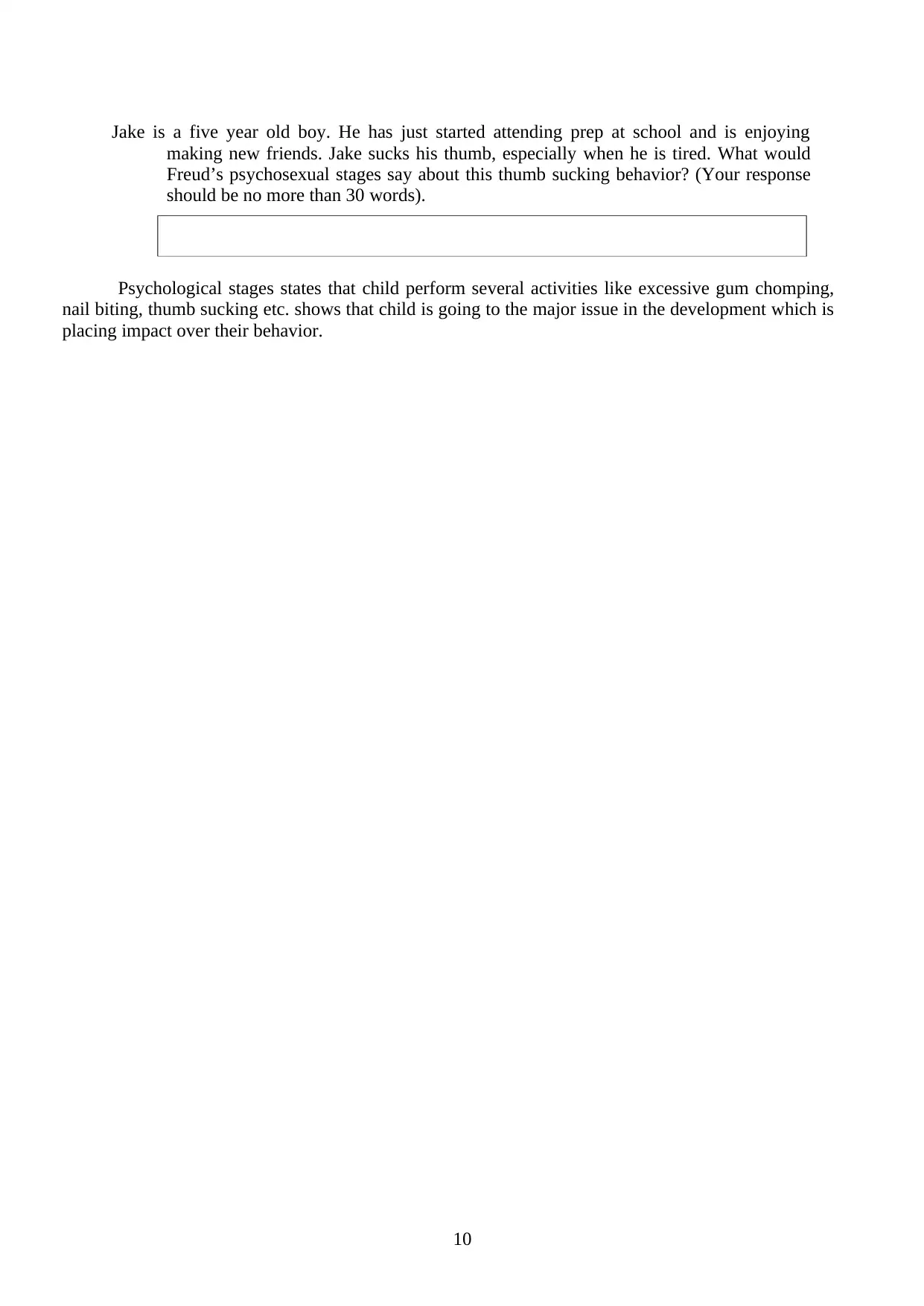
10
Jake is a five year old boy. He has just started attending prep at school and is enjoying
making new friends. Jake sucks his thumb, especially when he is tired. What would
Freud’s psychosexual stages say about this thumb sucking behavior? (Your response
should be no more than 30 words).
Psychological stages states that child perform several activities like excessive gum chomping,
nail biting, thumb sucking etc. shows that child is going to the major issue in the development which is
placing impact over their behavior.
Jake is a five year old boy. He has just started attending prep at school and is enjoying
making new friends. Jake sucks his thumb, especially when he is tired. What would
Freud’s psychosexual stages say about this thumb sucking behavior? (Your response
should be no more than 30 words).
Psychological stages states that child perform several activities like excessive gum chomping,
nail biting, thumb sucking etc. shows that child is going to the major issue in the development which is
placing impact over their behavior.
Secure Best Marks with AI Grader
Need help grading? Try our AI Grader for instant feedback on your assignments.
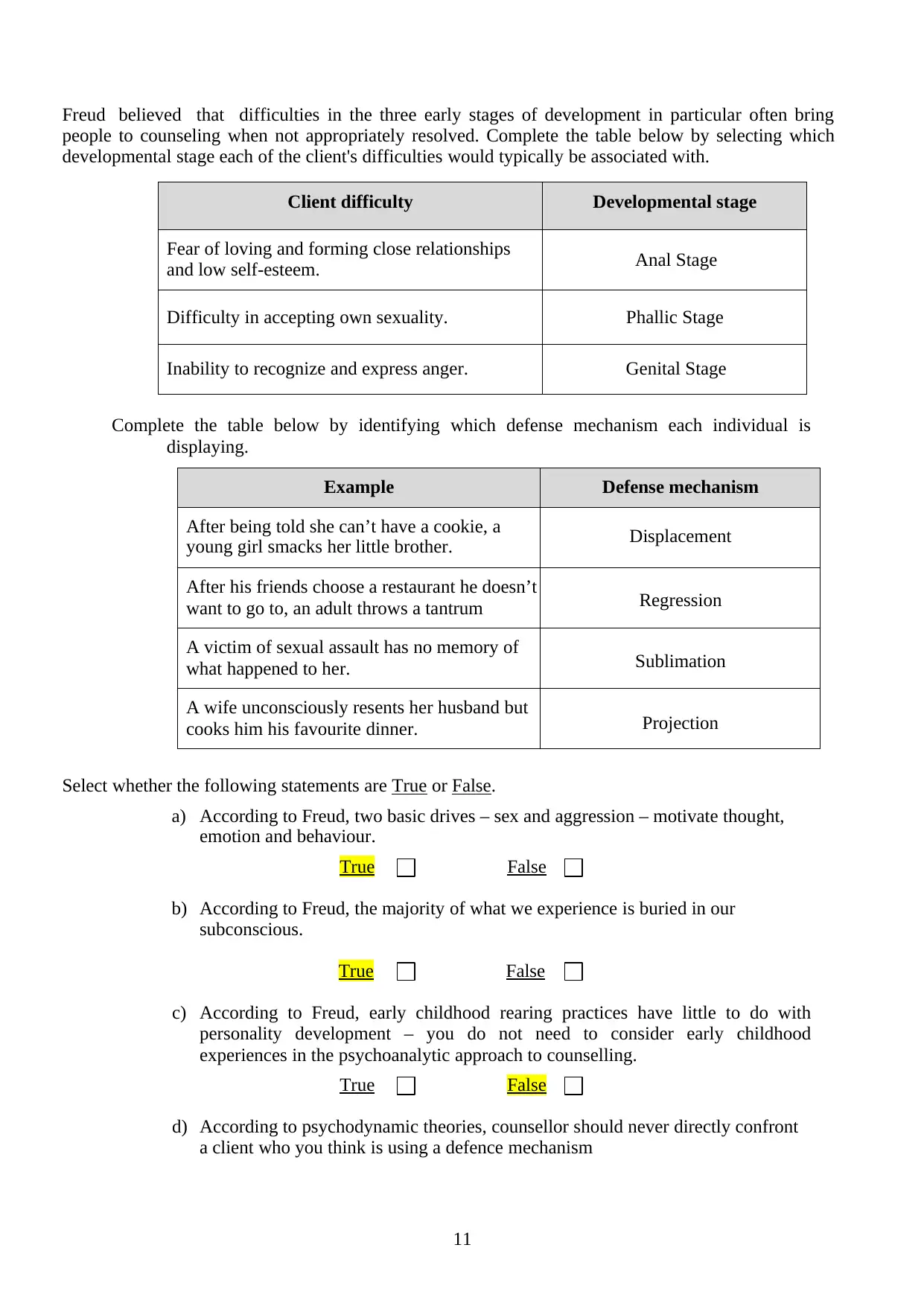
11
Freud believed that difficulties in the three early stages of development in particular often bring
people to counseling when not appropriately resolved. Complete the table below by selecting which
developmental stage each of the client's difficulties would typically be associated with.
Client difficulty Developmental stage
Fear of loving and forming close relationships
and low self-esteem. Anal Stage
Difficulty in accepting own sexuality. Phallic Stage
Inability to recognize and express anger. Genital Stage
Complete the table below by identifying which defense mechanism each individual is
displaying.
Example Defense mechanism
After being told she can’t have a cookie, a
young girl smacks her little brother. Displacement
After his friends choose a restaurant he doesn’t
want to go to, an adult throws a tantrum Regression
A victim of sexual assault has no memory of
what happened to her. Sublimation
A wife unconsciously resents her husband but
cooks him his favourite dinner. Projection
Select whether the following statements are True or False.
a) According to Freud, two basic drives – sex and aggression – motivate thought,
emotion and behaviour.
True False
b) According to Freud, the majority of what we experience is buried in our
subconscious.
True False
c) According to Freud, early childhood rearing practices have little to do with
personality development – you do not need to consider early childhood
experiences in the psychoanalytic approach to counselling.
True False
d) According to psychodynamic theories, counsellor should never directly confront
a client who you think is using a defence mechanism
Freud believed that difficulties in the three early stages of development in particular often bring
people to counseling when not appropriately resolved. Complete the table below by selecting which
developmental stage each of the client's difficulties would typically be associated with.
Client difficulty Developmental stage
Fear of loving and forming close relationships
and low self-esteem. Anal Stage
Difficulty in accepting own sexuality. Phallic Stage
Inability to recognize and express anger. Genital Stage
Complete the table below by identifying which defense mechanism each individual is
displaying.
Example Defense mechanism
After being told she can’t have a cookie, a
young girl smacks her little brother. Displacement
After his friends choose a restaurant he doesn’t
want to go to, an adult throws a tantrum Regression
A victim of sexual assault has no memory of
what happened to her. Sublimation
A wife unconsciously resents her husband but
cooks him his favourite dinner. Projection
Select whether the following statements are True or False.
a) According to Freud, two basic drives – sex and aggression – motivate thought,
emotion and behaviour.
True False
b) According to Freud, the majority of what we experience is buried in our
subconscious.
True False
c) According to Freud, early childhood rearing practices have little to do with
personality development – you do not need to consider early childhood
experiences in the psychoanalytic approach to counselling.
True False
d) According to psychodynamic theories, counsellor should never directly confront
a client who you think is using a defence mechanism
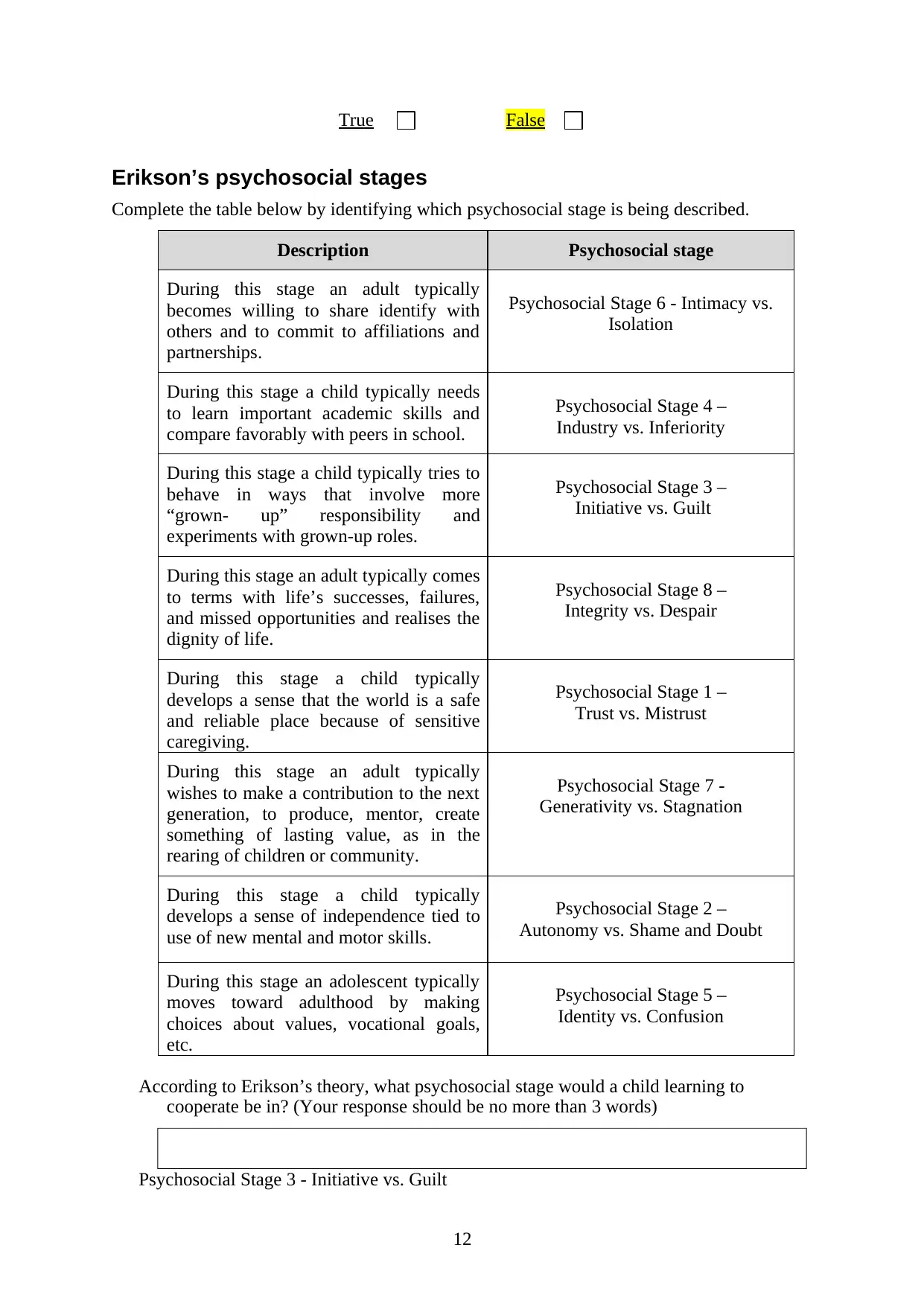
12
True False
Erikson’s psychosocial stages
Complete the table below by identifying which psychosocial stage is being described.
Description Psychosocial stage
During this stage an adult typically
becomes willing to share identify with
others and to commit to affiliations and
partnerships.
Psychosocial Stage 6 - Intimacy vs.
Isolation
During this stage a child typically needs
to learn important academic skills and
compare favorably with peers in school.
Psychosocial Stage 4 –
Industry vs. Inferiority
During this stage a child typically tries to
behave in ways that involve more
“grown- up” responsibility and
experiments with grown-up roles.
Psychosocial Stage 3 –
Initiative vs. Guilt
During this stage an adult typically comes
to terms with life’s successes, failures,
and missed opportunities and realises the
dignity of life.
Psychosocial Stage 8 –
Integrity vs. Despair
During this stage a child typically
develops a sense that the world is a safe
and reliable place because of sensitive
caregiving.
Psychosocial Stage 1 –
Trust vs. Mistrust
During this stage an adult typically
wishes to make a contribution to the next
generation, to produce, mentor, create
something of lasting value, as in the
rearing of children or community.
Psychosocial Stage 7 -
Generativity vs. Stagnation
During this stage a child typically
develops a sense of independence tied to
use of new mental and motor skills.
Psychosocial Stage 2 –
Autonomy vs. Shame and Doubt
During this stage an adolescent typically
moves toward adulthood by making
choices about values, vocational goals,
etc.
Psychosocial Stage 5 –
Identity vs. Confusion
According to Erikson’s theory, what psychosocial stage would a child learning to
cooperate be in? (Your response should be no more than 3 words)
Psychosocial Stage 3 - Initiative vs. Guilt
True False
Erikson’s psychosocial stages
Complete the table below by identifying which psychosocial stage is being described.
Description Psychosocial stage
During this stage an adult typically
becomes willing to share identify with
others and to commit to affiliations and
partnerships.
Psychosocial Stage 6 - Intimacy vs.
Isolation
During this stage a child typically needs
to learn important academic skills and
compare favorably with peers in school.
Psychosocial Stage 4 –
Industry vs. Inferiority
During this stage a child typically tries to
behave in ways that involve more
“grown- up” responsibility and
experiments with grown-up roles.
Psychosocial Stage 3 –
Initiative vs. Guilt
During this stage an adult typically comes
to terms with life’s successes, failures,
and missed opportunities and realises the
dignity of life.
Psychosocial Stage 8 –
Integrity vs. Despair
During this stage a child typically
develops a sense that the world is a safe
and reliable place because of sensitive
caregiving.
Psychosocial Stage 1 –
Trust vs. Mistrust
During this stage an adult typically
wishes to make a contribution to the next
generation, to produce, mentor, create
something of lasting value, as in the
rearing of children or community.
Psychosocial Stage 7 -
Generativity vs. Stagnation
During this stage a child typically
develops a sense of independence tied to
use of new mental and motor skills.
Psychosocial Stage 2 –
Autonomy vs. Shame and Doubt
During this stage an adolescent typically
moves toward adulthood by making
choices about values, vocational goals,
etc.
Psychosocial Stage 5 –
Identity vs. Confusion
According to Erikson’s theory, what psychosocial stage would a child learning to
cooperate be in? (Your response should be no more than 3 words)
Psychosocial Stage 3 - Initiative vs. Guilt
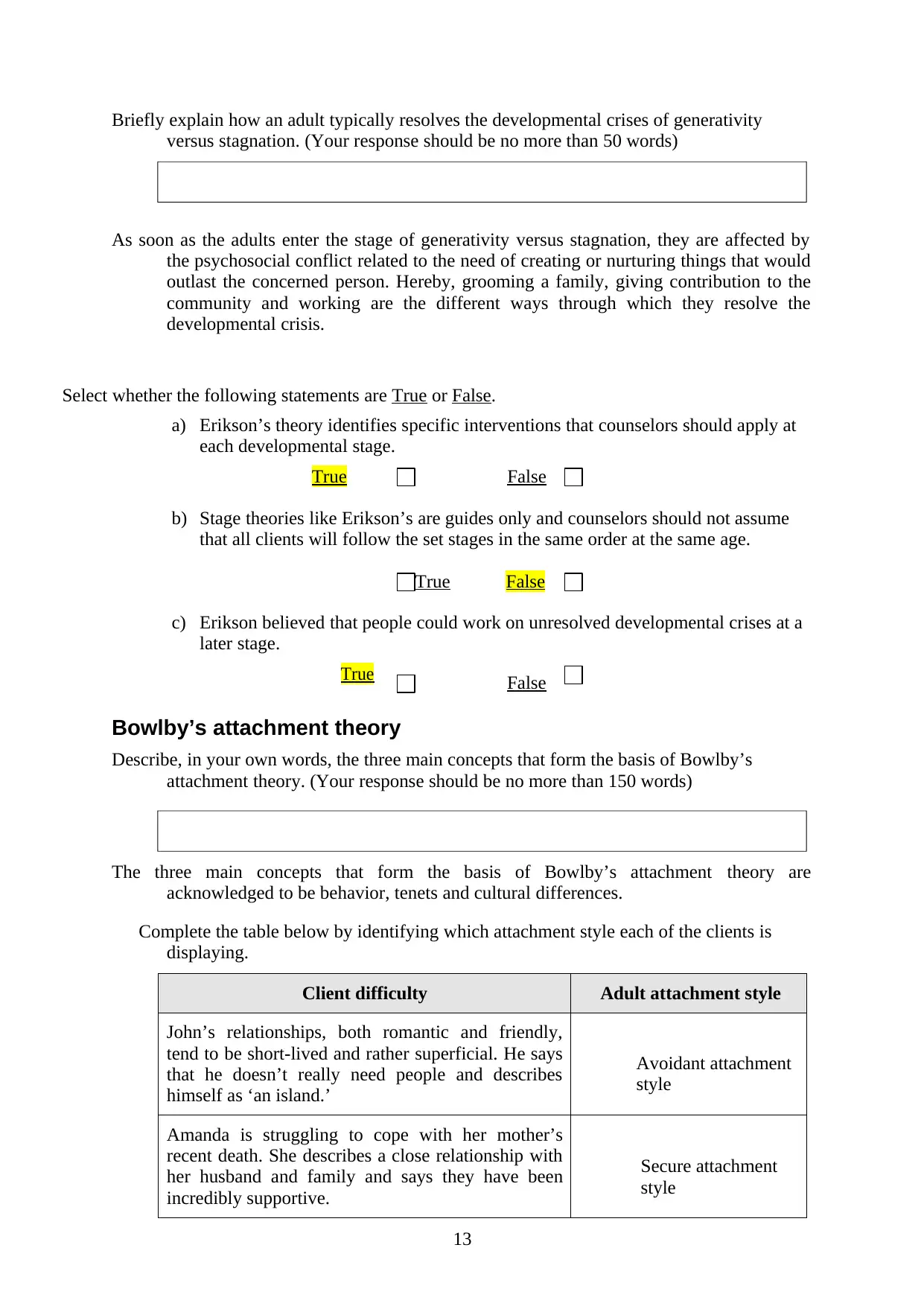
13
Briefly explain how an adult typically resolves the developmental crises of generativity
versus stagnation. (Your response should be no more than 50 words)
As soon as the adults enter the stage of generativity versus stagnation, they are affected by
the psychosocial conflict related to the need of creating or nurturing things that would
outlast the concerned person. Hereby, grooming a family, giving contribution to the
community and working are the different ways through which they resolve the
developmental crisis.
Select whether the following statements are True or False.
a) Erikson’s theory identifies specific interventions that counselors should apply at
each developmental stage.
True False
b) Stage theories like Erikson’s are guides only and counselors should not assume
that all clients will follow the set stages in the same order at the same age.
True False
c) Erikson believed that people could work on unresolved developmental crises at a
later stage.
True
Bowlby’s attachment theory
False
Describe, in your own words, the three main concepts that form the basis of Bowlby’s
attachment theory. (Your response should be no more than 150 words)
The three main concepts that form the basis of Bowlby’s attachment theory are
acknowledged to be behavior, tenets and cultural differences.
Complete the table below by identifying which attachment style each of the clients is
displaying.
Client difficulty Adult attachment style
John’s relationships, both romantic and friendly,
tend to be short-lived and rather superficial. He says
that he doesn’t really need people and describes
himself as ‘an island.’
Avoidant attachment
style
Amanda is struggling to cope with her mother’s
recent death. She describes a close relationship with
her husband and family and says they have been
incredibly supportive.
Secure attachment
style
Briefly explain how an adult typically resolves the developmental crises of generativity
versus stagnation. (Your response should be no more than 50 words)
As soon as the adults enter the stage of generativity versus stagnation, they are affected by
the psychosocial conflict related to the need of creating or nurturing things that would
outlast the concerned person. Hereby, grooming a family, giving contribution to the
community and working are the different ways through which they resolve the
developmental crisis.
Select whether the following statements are True or False.
a) Erikson’s theory identifies specific interventions that counselors should apply at
each developmental stage.
True False
b) Stage theories like Erikson’s are guides only and counselors should not assume
that all clients will follow the set stages in the same order at the same age.
True False
c) Erikson believed that people could work on unresolved developmental crises at a
later stage.
True
Bowlby’s attachment theory
False
Describe, in your own words, the three main concepts that form the basis of Bowlby’s
attachment theory. (Your response should be no more than 150 words)
The three main concepts that form the basis of Bowlby’s attachment theory are
acknowledged to be behavior, tenets and cultural differences.
Complete the table below by identifying which attachment style each of the clients is
displaying.
Client difficulty Adult attachment style
John’s relationships, both romantic and friendly,
tend to be short-lived and rather superficial. He says
that he doesn’t really need people and describes
himself as ‘an island.’
Avoidant attachment
style
Amanda is struggling to cope with her mother’s
recent death. She describes a close relationship with
her husband and family and says they have been
incredibly supportive.
Secure attachment
style
Paraphrase This Document
Need a fresh take? Get an instant paraphrase of this document with our AI Paraphraser

14
Mary attends her first counselling session in tears.
Her boyfriend of three months has just ended their
relationship and she has spent the entire night calling
him repeatedly begging him to reconsider. She says
she is ‘nothing’ without him.
Disordered
attachment
Mary attends her first counselling session in tears.
Her boyfriend of three months has just ended their
relationship and she has spent the entire night calling
him repeatedly begging him to reconsider. She says
she is ‘nothing’ without him.
Disordered
attachment
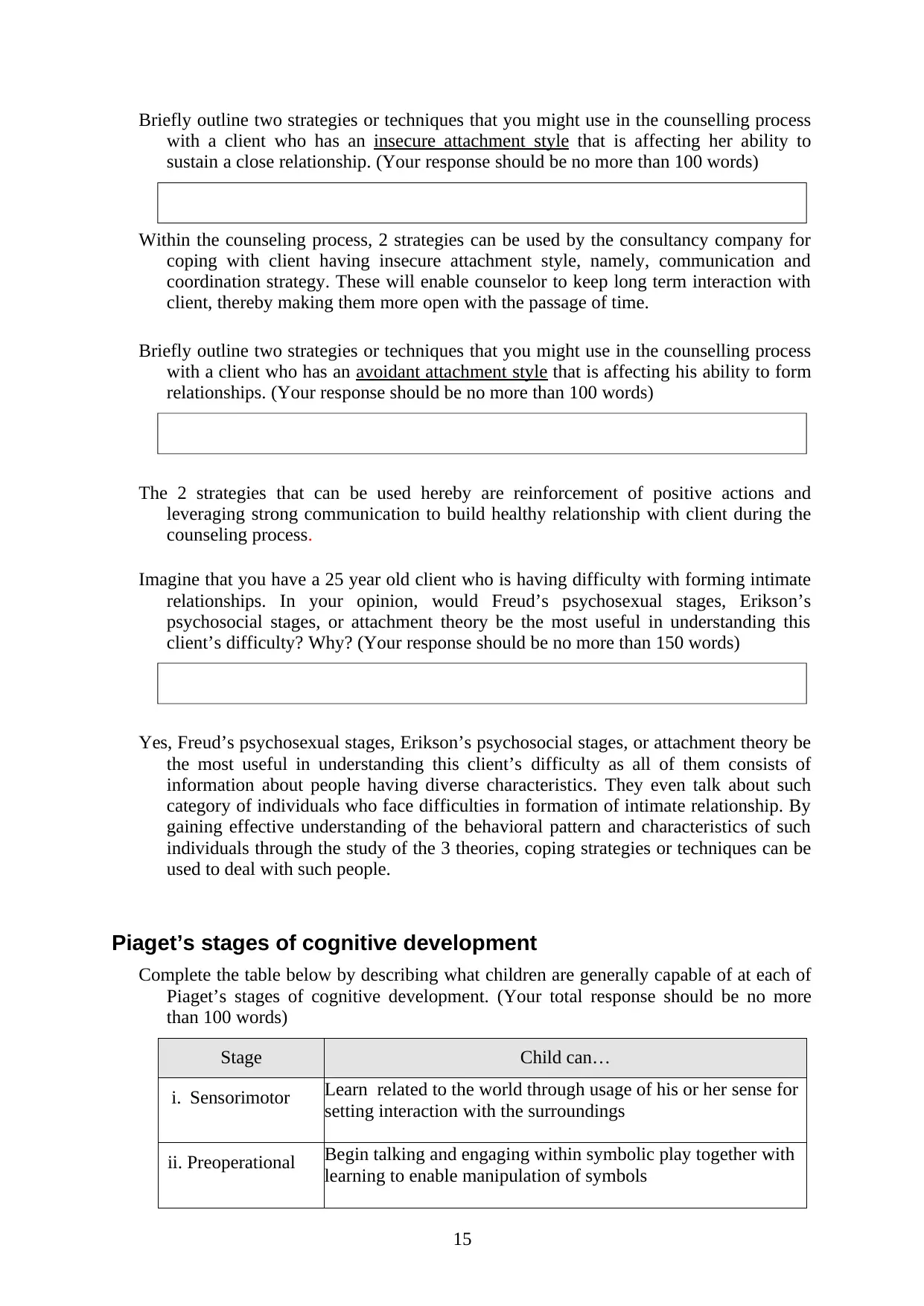
15
Briefly outline two strategies or techniques that you might use in the counselling process
with a client who has an insecure attachment style that is affecting her ability to
sustain a close relationship. (Your response should be no more than 100 words)
Within the counseling process, 2 strategies can be used by the consultancy company for
coping with client having insecure attachment style, namely, communication and
coordination strategy. These will enable counselor to keep long term interaction with
client, thereby making them more open with the passage of time.
Briefly outline two strategies or techniques that you might use in the counselling process
with a client who has an avoidant attachment style that is affecting his ability to form
relationships. (Your response should be no more than 100 words)
The 2 strategies that can be used hereby are reinforcement of positive actions and
leveraging strong communication to build healthy relationship with client during the
counseling process.
Imagine that you have a 25 year old client who is having difficulty with forming intimate
relationships. In your opinion, would Freud’s psychosexual stages, Erikson’s
psychosocial stages, or attachment theory be the most useful in understanding this
client’s difficulty? Why? (Your response should be no more than 150 words)
Yes, Freud’s psychosexual stages, Erikson’s psychosocial stages, or attachment theory be
the most useful in understanding this client’s difficulty as all of them consists of
information about people having diverse characteristics. They even talk about such
category of individuals who face difficulties in formation of intimate relationship. By
gaining effective understanding of the behavioral pattern and characteristics of such
individuals through the study of the 3 theories, coping strategies or techniques can be
used to deal with such people.
Piaget’s stages of cognitive development
Complete the table below by describing what children are generally capable of at each of
Piaget’s stages of cognitive development. (Your total response should be no more
than 100 words)
Stage Child can…
i. Sensorimotor Learn related to the world through usage of his or her sense for
setting interaction with the surroundings
ii. Preoperational Begin talking and engaging within symbolic play together with
learning to enable manipulation of symbols
Briefly outline two strategies or techniques that you might use in the counselling process
with a client who has an insecure attachment style that is affecting her ability to
sustain a close relationship. (Your response should be no more than 100 words)
Within the counseling process, 2 strategies can be used by the consultancy company for
coping with client having insecure attachment style, namely, communication and
coordination strategy. These will enable counselor to keep long term interaction with
client, thereby making them more open with the passage of time.
Briefly outline two strategies or techniques that you might use in the counselling process
with a client who has an avoidant attachment style that is affecting his ability to form
relationships. (Your response should be no more than 100 words)
The 2 strategies that can be used hereby are reinforcement of positive actions and
leveraging strong communication to build healthy relationship with client during the
counseling process.
Imagine that you have a 25 year old client who is having difficulty with forming intimate
relationships. In your opinion, would Freud’s psychosexual stages, Erikson’s
psychosocial stages, or attachment theory be the most useful in understanding this
client’s difficulty? Why? (Your response should be no more than 150 words)
Yes, Freud’s psychosexual stages, Erikson’s psychosocial stages, or attachment theory be
the most useful in understanding this client’s difficulty as all of them consists of
information about people having diverse characteristics. They even talk about such
category of individuals who face difficulties in formation of intimate relationship. By
gaining effective understanding of the behavioral pattern and characteristics of such
individuals through the study of the 3 theories, coping strategies or techniques can be
used to deal with such people.
Piaget’s stages of cognitive development
Complete the table below by describing what children are generally capable of at each of
Piaget’s stages of cognitive development. (Your total response should be no more
than 100 words)
Stage Child can…
i. Sensorimotor Learn related to the world through usage of his or her sense for
setting interaction with the surroundings
ii. Preoperational Begin talking and engaging within symbolic play together with
learning to enable manipulation of symbols

16
iii. Concrete
operational
Start developing logical thinking at this stage
iv. Formal
operational
Begin thinking in an abstract way through manipulation of ideas
within their heads, while ensuring no dependence over concrete
manipulations
How can Piaget’s theory guide adult counselling? (Your response should be no more than 50
words)
Piaget’s theory consists of 4 stages which talk about the development of child’s abilities and
characteristics. Through the study of these stages of a child in an effective manner, a
counselor can gain understanding of the manner in which a child grew up and thus
carry out adult counseling accordingly.
Select whether the following statements are True or False.
a) At the concrete operational stage, a child is capable of complex, abstract
thought True False
iii. Concrete
operational
Start developing logical thinking at this stage
iv. Formal
operational
Begin thinking in an abstract way through manipulation of ideas
within their heads, while ensuring no dependence over concrete
manipulations
How can Piaget’s theory guide adult counselling? (Your response should be no more than 50
words)
Piaget’s theory consists of 4 stages which talk about the development of child’s abilities and
characteristics. Through the study of these stages of a child in an effective manner, a
counselor can gain understanding of the manner in which a child grew up and thus
carry out adult counseling accordingly.
Select whether the following statements are True or False.
a) At the concrete operational stage, a child is capable of complex, abstract
thought True False
Secure Best Marks with AI Grader
Need help grading? Try our AI Grader for instant feedback on your assignments.

17
b) Assimilation refers to the processing of new information through what is already
known.
True False
c) According to Piaget, Jack (aged 5 years) should be able to see things from his
friend’s perspective.
True False
Maslow’s hierarchy of needs
For each of the scenarios below, identify what level of Maslow’s hierarchy of needs the
person is most likely working at. (Each response should be no more than 5 words)
a) Andrew works two hours overtime every night. He needs the extra money to
cover the mortgage on the home for the family’s stability.
Stage 2: Safety stage:
b) Marina is a single parent with three children. She is on a low income and has little
money for groceries after paying rent and electricity. Although she sees a lovely
dress that she would like to buy, she spends all of her remaining income on the
fortnight’s groceries.
Stage 1: Physiological stage
c) After many weeks of looking, Marina has now found part-time work and has extra
income as a result. She feels good about herself and now buys herself the lovely
dress she has admired for weeks.
Stage 4: Esteem stage
d) Eduardo (aged 55) is a professor at a university. He has recently retired from his
position in order to fulfil a lifelong desire to write novels.
Stage 5: Self actualization needs
e) Deborah has moved to a new city on a work transfer. She is lonely and has
enrolled in a local ballroom dancing class in order to make new friends.
Stage 4: Love and belongingness
How could a counsellor use Maslow’s hierarchy of needs in counselling practice? (Your
b) Assimilation refers to the processing of new information through what is already
known.
True False
c) According to Piaget, Jack (aged 5 years) should be able to see things from his
friend’s perspective.
True False
Maslow’s hierarchy of needs
For each of the scenarios below, identify what level of Maslow’s hierarchy of needs the
person is most likely working at. (Each response should be no more than 5 words)
a) Andrew works two hours overtime every night. He needs the extra money to
cover the mortgage on the home for the family’s stability.
Stage 2: Safety stage:
b) Marina is a single parent with three children. She is on a low income and has little
money for groceries after paying rent and electricity. Although she sees a lovely
dress that she would like to buy, she spends all of her remaining income on the
fortnight’s groceries.
Stage 1: Physiological stage
c) After many weeks of looking, Marina has now found part-time work and has extra
income as a result. She feels good about herself and now buys herself the lovely
dress she has admired for weeks.
Stage 4: Esteem stage
d) Eduardo (aged 55) is a professor at a university. He has recently retired from his
position in order to fulfil a lifelong desire to write novels.
Stage 5: Self actualization needs
e) Deborah has moved to a new city on a work transfer. She is lonely and has
enrolled in a local ballroom dancing class in order to make new friends.
Stage 4: Love and belongingness
How could a counsellor use Maslow’s hierarchy of needs in counselling practice? (Your

18
response should be no more than 100 words)
Maslow’s hierarchy of needs is determined as the effective theory which is being used by the
individuals especially counselor in order to develop understanding on the specific needs of client. This
simply helps counselor in knowing diversified need of the client. Thus, by analyzing actual stage of the
client counselor can easily motivate their client so that they can easily recover from the trauma and
could successfully gain confidence to deal with the situation. In addition to this, it systematically
supports counselor in the execution of their professional duty in adequate manner.
response should be no more than 100 words)
Maslow’s hierarchy of needs is determined as the effective theory which is being used by the
individuals especially counselor in order to develop understanding on the specific needs of client. This
simply helps counselor in knowing diversified need of the client. Thus, by analyzing actual stage of the
client counselor can easily motivate their client so that they can easily recover from the trauma and
could successfully gain confidence to deal with the situation. In addition to this, it systematically
supports counselor in the execution of their professional duty in adequate manner.

19
According to Maslow’s hierarchy of needs, what are the characteristics of someone who has
found self-actualisation? (Your response should be no more than 50 words)
Task centering, efficient perception of reality, comfortable acceptance of self, others,
spontaneous and natural, autonomy, continued with the freshness of appreciation are
determined as some of common characteristic of Maslow’s hierarchy theory of needs
which is being especially identified in the stage of self actualization.
Emerging trends in development
Select whether the following statements are True or False.
a) There are cultural differences in how people define themselves and relate to
others. True False
b) Current research suggests that it is important for counsellors to take a
“multidimensional view” of development that considers both genetics and the
environment, including culture.
True
Integrating your knowledge
The following questions require you to
False
draw upon all of the knowledge and skills you have
According to Maslow’s hierarchy of needs, what are the characteristics of someone who has
found self-actualisation? (Your response should be no more than 50 words)
Task centering, efficient perception of reality, comfortable acceptance of self, others,
spontaneous and natural, autonomy, continued with the freshness of appreciation are
determined as some of common characteristic of Maslow’s hierarchy theory of needs
which is being especially identified in the stage of self actualization.
Emerging trends in development
Select whether the following statements are True or False.
a) There are cultural differences in how people define themselves and relate to
others. True False
b) Current research suggests that it is important for counsellors to take a
“multidimensional view” of development that considers both genetics and the
environment, including culture.
True
Integrating your knowledge
The following questions require you to
False
draw upon all of the knowledge and skills you have
Paraphrase This Document
Need a fresh take? Get an instant paraphrase of this document with our AI Paraphraser
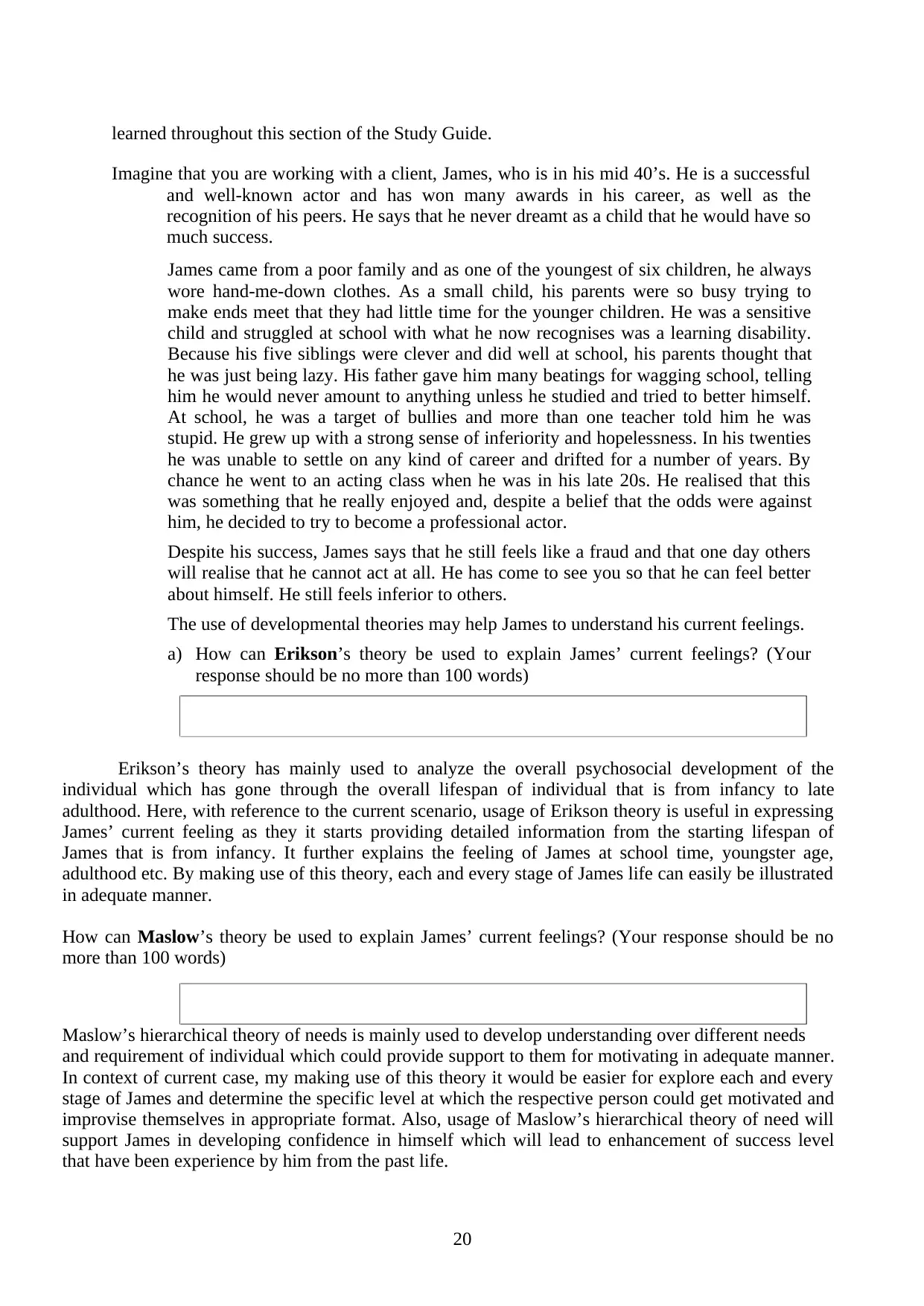
20
learned throughout this section of the Study Guide.
Imagine that you are working with a client, James, who is in his mid 40’s. He is a successful
and well-known actor and has won many awards in his career, as well as the
recognition of his peers. He says that he never dreamt as a child that he would have so
much success.
James came from a poor family and as one of the youngest of six children, he always
wore hand-me-down clothes. As a small child, his parents were so busy trying to
make ends meet that they had little time for the younger children. He was a sensitive
child and struggled at school with what he now recognises was a learning disability.
Because his five siblings were clever and did well at school, his parents thought that
he was just being lazy. His father gave him many beatings for wagging school, telling
him he would never amount to anything unless he studied and tried to better himself.
At school, he was a target of bullies and more than one teacher told him he was
stupid. He grew up with a strong sense of inferiority and hopelessness. In his twenties
he was unable to settle on any kind of career and drifted for a number of years. By
chance he went to an acting class when he was in his late 20s. He realised that this
was something that he really enjoyed and, despite a belief that the odds were against
him, he decided to try to become a professional actor.
Despite his success, James says that he still feels like a fraud and that one day others
will realise that he cannot act at all. He has come to see you so that he can feel better
about himself. He still feels inferior to others.
The use of developmental theories may help James to understand his current feelings.
a) How can Erikson’s theory be used to explain James’ current feelings? (Your
response should be no more than 100 words)
Erikson’s theory has mainly used to analyze the overall psychosocial development of the
individual which has gone through the overall lifespan of individual that is from infancy to late
adulthood. Here, with reference to the current scenario, usage of Erikson theory is useful in expressing
James’ current feeling as they it starts providing detailed information from the starting lifespan of
James that is from infancy. It further explains the feeling of James at school time, youngster age,
adulthood etc. By making use of this theory, each and every stage of James life can easily be illustrated
in adequate manner.
How can Maslow’s theory be used to explain James’ current feelings? (Your response should be no
more than 100 words)
Maslow’s hierarchical theory of needs is mainly used to develop understanding over different needs
and requirement of individual which could provide support to them for motivating in adequate manner.
In context of current case, my making use of this theory it would be easier for explore each and every
stage of James and determine the specific level at which the respective person could get motivated and
improvise themselves in appropriate format. Also, usage of Maslow’s hierarchical theory of need will
support James in developing confidence in himself which will lead to enhancement of success level
that have been experience by him from the past life.
learned throughout this section of the Study Guide.
Imagine that you are working with a client, James, who is in his mid 40’s. He is a successful
and well-known actor and has won many awards in his career, as well as the
recognition of his peers. He says that he never dreamt as a child that he would have so
much success.
James came from a poor family and as one of the youngest of six children, he always
wore hand-me-down clothes. As a small child, his parents were so busy trying to
make ends meet that they had little time for the younger children. He was a sensitive
child and struggled at school with what he now recognises was a learning disability.
Because his five siblings were clever and did well at school, his parents thought that
he was just being lazy. His father gave him many beatings for wagging school, telling
him he would never amount to anything unless he studied and tried to better himself.
At school, he was a target of bullies and more than one teacher told him he was
stupid. He grew up with a strong sense of inferiority and hopelessness. In his twenties
he was unable to settle on any kind of career and drifted for a number of years. By
chance he went to an acting class when he was in his late 20s. He realised that this
was something that he really enjoyed and, despite a belief that the odds were against
him, he decided to try to become a professional actor.
Despite his success, James says that he still feels like a fraud and that one day others
will realise that he cannot act at all. He has come to see you so that he can feel better
about himself. He still feels inferior to others.
The use of developmental theories may help James to understand his current feelings.
a) How can Erikson’s theory be used to explain James’ current feelings? (Your
response should be no more than 100 words)
Erikson’s theory has mainly used to analyze the overall psychosocial development of the
individual which has gone through the overall lifespan of individual that is from infancy to late
adulthood. Here, with reference to the current scenario, usage of Erikson theory is useful in expressing
James’ current feeling as they it starts providing detailed information from the starting lifespan of
James that is from infancy. It further explains the feeling of James at school time, youngster age,
adulthood etc. By making use of this theory, each and every stage of James life can easily be illustrated
in adequate manner.
How can Maslow’s theory be used to explain James’ current feelings? (Your response should be no
more than 100 words)
Maslow’s hierarchical theory of needs is mainly used to develop understanding over different needs
and requirement of individual which could provide support to them for motivating in adequate manner.
In context of current case, my making use of this theory it would be easier for explore each and every
stage of James and determine the specific level at which the respective person could get motivated and
improvise themselves in appropriate format. Also, usage of Maslow’s hierarchical theory of need will
support James in developing confidence in himself which will lead to enhancement of success level
that have been experience by him from the past life.
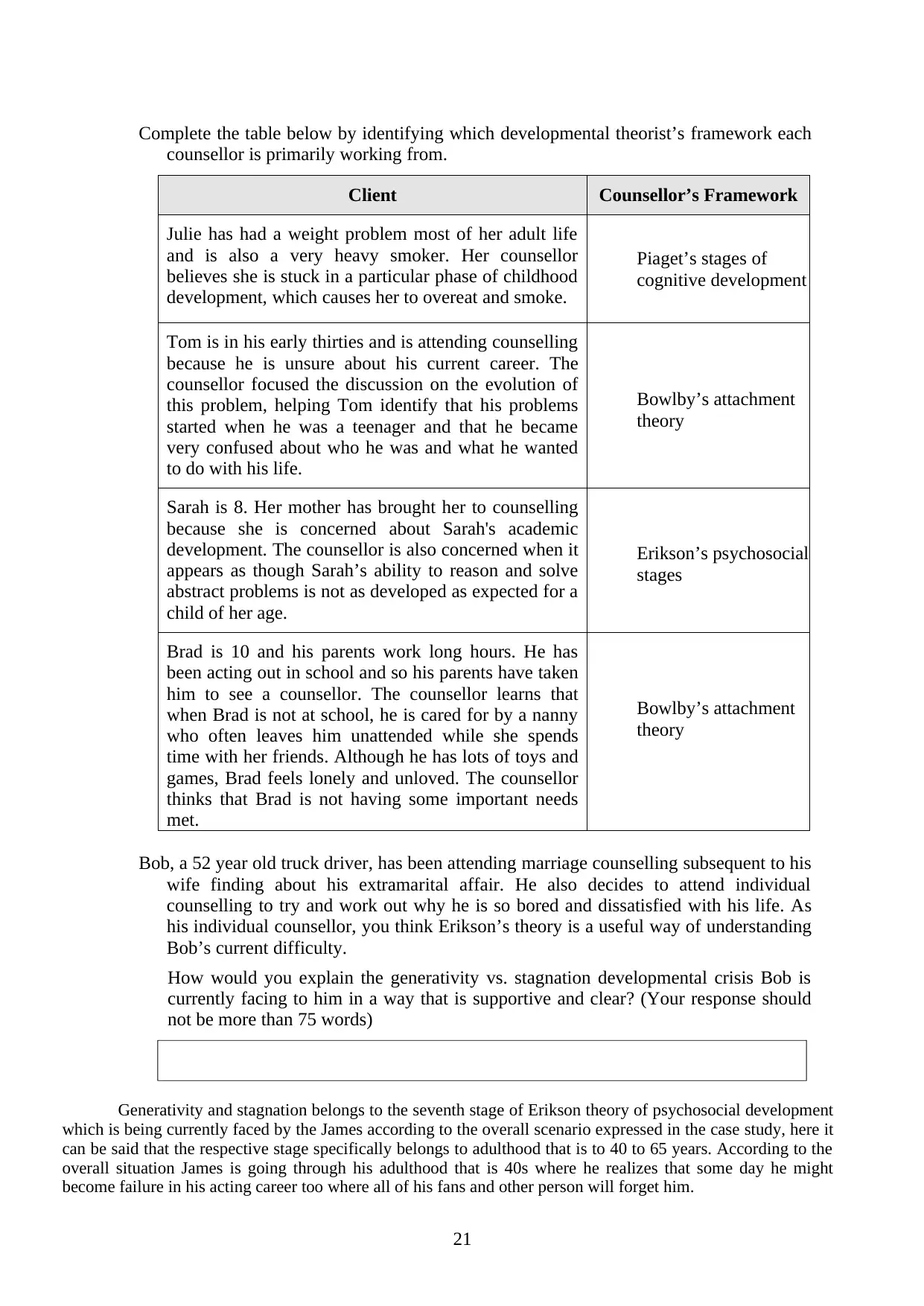
21
Complete the table below by identifying which developmental theorist’s framework each
counsellor is primarily working from.
Client Counsellor’s Framework
Julie has had a weight problem most of her adult life
and is also a very heavy smoker. Her counsellor
believes she is stuck in a particular phase of childhood
development, which causes her to overeat and smoke.
Piaget’s stages of
cognitive development
Tom is in his early thirties and is attending counselling
because he is unsure about his current career. The
counsellor focused the discussion on the evolution of
this problem, helping Tom identify that his problems
started when he was a teenager and that he became
very confused about who he was and what he wanted
to do with his life.
Bowlby’s attachment
theory
Sarah is 8. Her mother has brought her to counselling
because she is concerned about Sarah's academic
development. The counsellor is also concerned when it
appears as though Sarah’s ability to reason and solve
abstract problems is not as developed as expected for a
child of her age.
Erikson’s psychosocial
stages
Brad is 10 and his parents work long hours. He has
been acting out in school and so his parents have taken
him to see a counsellor. The counsellor learns that
when Brad is not at school, he is cared for by a nanny
who often leaves him unattended while she spends
time with her friends. Although he has lots of toys and
games, Brad feels lonely and unloved. The counsellor
thinks that Brad is not having some important needs
met.
Bowlby’s attachment
theory
Bob, a 52 year old truck driver, has been attending marriage counselling subsequent to his
wife finding about his extramarital affair. He also decides to attend individual
counselling to try and work out why he is so bored and dissatisfied with his life. As
his individual counsellor, you think Erikson’s theory is a useful way of understanding
Bob’s current difficulty.
How would you explain the generativity vs. stagnation developmental crisis Bob is
currently facing to him in a way that is supportive and clear? (Your response should
not be more than 75 words)
Generativity and stagnation belongs to the seventh stage of Erikson theory of psychosocial development
which is being currently faced by the James according to the overall scenario expressed in the case study, here it
can be said that the respective stage specifically belongs to adulthood that is to 40 to 65 years. According to the
overall situation James is going through his adulthood that is 40s where he realizes that some day he might
become failure in his acting career too where all of his fans and other person will forget him.
Complete the table below by identifying which developmental theorist’s framework each
counsellor is primarily working from.
Client Counsellor’s Framework
Julie has had a weight problem most of her adult life
and is also a very heavy smoker. Her counsellor
believes she is stuck in a particular phase of childhood
development, which causes her to overeat and smoke.
Piaget’s stages of
cognitive development
Tom is in his early thirties and is attending counselling
because he is unsure about his current career. The
counsellor focused the discussion on the evolution of
this problem, helping Tom identify that his problems
started when he was a teenager and that he became
very confused about who he was and what he wanted
to do with his life.
Bowlby’s attachment
theory
Sarah is 8. Her mother has brought her to counselling
because she is concerned about Sarah's academic
development. The counsellor is also concerned when it
appears as though Sarah’s ability to reason and solve
abstract problems is not as developed as expected for a
child of her age.
Erikson’s psychosocial
stages
Brad is 10 and his parents work long hours. He has
been acting out in school and so his parents have taken
him to see a counsellor. The counsellor learns that
when Brad is not at school, he is cared for by a nanny
who often leaves him unattended while she spends
time with her friends. Although he has lots of toys and
games, Brad feels lonely and unloved. The counsellor
thinks that Brad is not having some important needs
met.
Bowlby’s attachment
theory
Bob, a 52 year old truck driver, has been attending marriage counselling subsequent to his
wife finding about his extramarital affair. He also decides to attend individual
counselling to try and work out why he is so bored and dissatisfied with his life. As
his individual counsellor, you think Erikson’s theory is a useful way of understanding
Bob’s current difficulty.
How would you explain the generativity vs. stagnation developmental crisis Bob is
currently facing to him in a way that is supportive and clear? (Your response should
not be more than 75 words)
Generativity and stagnation belongs to the seventh stage of Erikson theory of psychosocial development
which is being currently faced by the James according to the overall scenario expressed in the case study, here it
can be said that the respective stage specifically belongs to adulthood that is to 40 to 65 years. According to the
overall situation James is going through his adulthood that is 40s where he realizes that some day he might
become failure in his acting career too where all of his fans and other person will forget him.
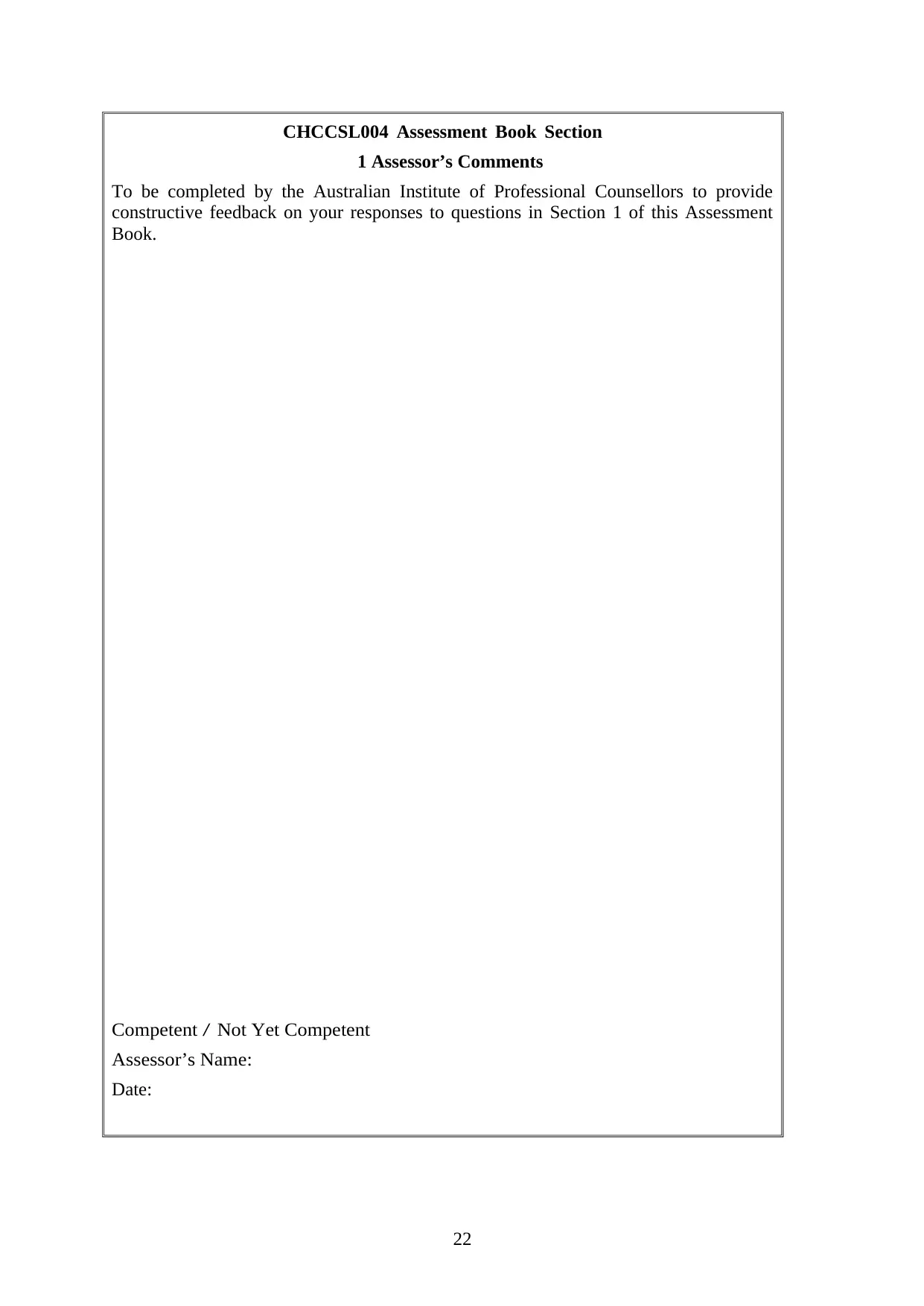
22
CHCCSL004 Assessment Book Section
1 Assessor’s Comments
To be completed by the Australian Institute of Professional Counsellors to provide
constructive feedback on your responses to questions in Section 1 of this Assessment
Book.
Competent / Not Yet Competent
Assessor’s Name:
Date:
CHCCSL004 Assessment Book Section
1 Assessor’s Comments
To be completed by the Australian Institute of Professional Counsellors to provide
constructive feedback on your responses to questions in Section 1 of this Assessment
Book.
Competent / Not Yet Competent
Assessor’s Name:
Date:
Secure Best Marks with AI Grader
Need help grading? Try our AI Grader for instant feedback on your assignments.
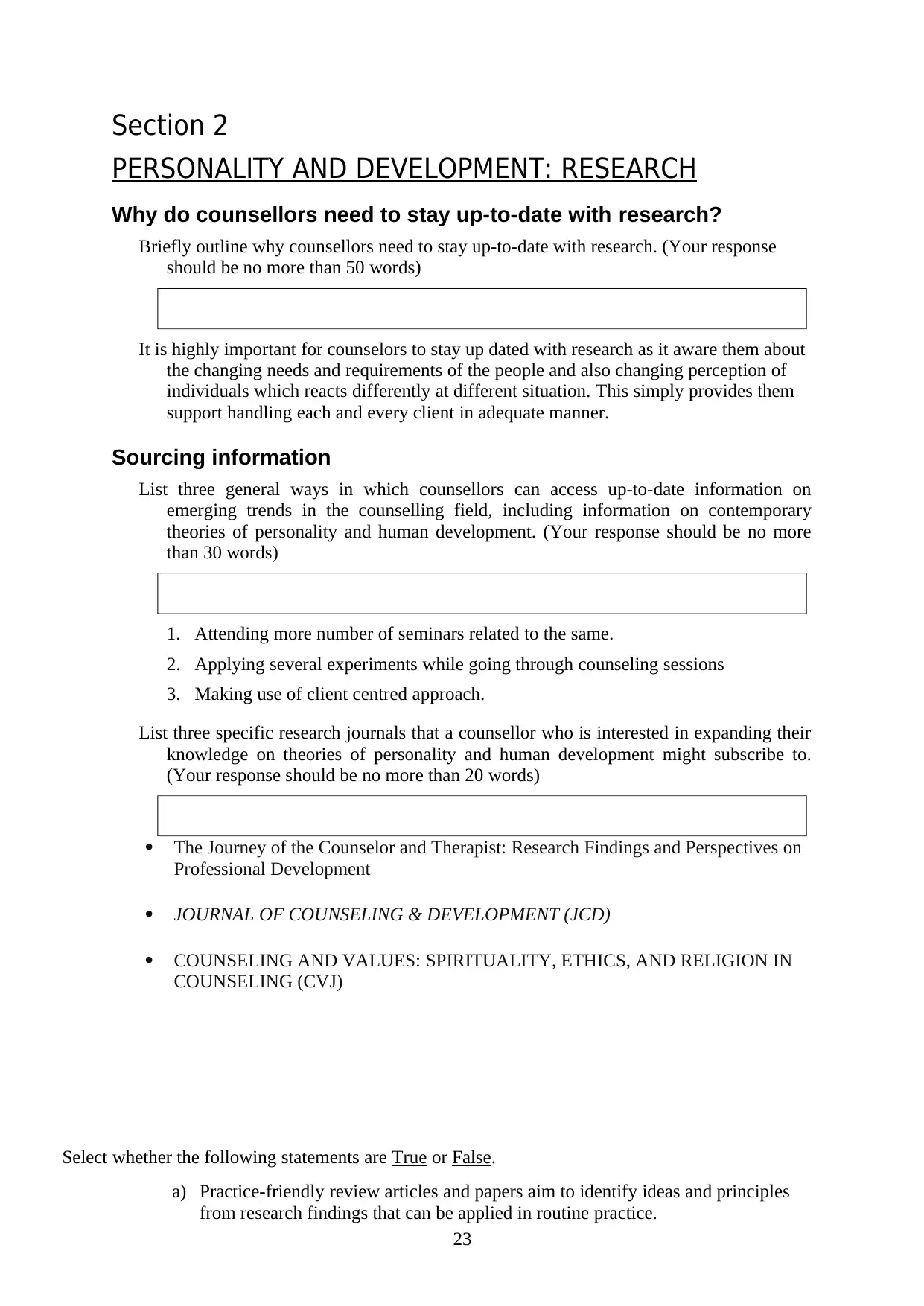
23
Section 2
PERSONALITY AND DEVELOPMENT: RESEARCH
Why do counsellors need to stay up-to-date with research?
Briefly outline why counsellors need to stay up-to-date with research. (Your response
should be no more than 50 words)
It is highly important for counselors to stay up dated with research as it aware them about
the changing needs and requirements of the people and also changing perception of
individuals which reacts differently at different situation. This simply provides them
support handling each and every client in adequate manner.
Sourcing information
List three general ways in which counsellors can access up-to-date information on
emerging trends in the counselling field, including information on contemporary
theories of personality and human development. (Your response should be no more
than 30 words)
1. Attending more number of seminars related to the same.
2. Applying several experiments while going through counseling sessions
3. Making use of client centred approach.
List three specific research journals that a counsellor who is interested in expanding their
knowledge on theories of personality and human development might subscribe to.
(Your response should be no more than 20 words)
The Journey of the Counselor and Therapist: Research Findings and Perspectives on
Professional Development
JOURNAL OF COUNSELING & DEVELOPMENT (JCD)
COUNSELING AND VALUES: SPIRITUALITY, ETHICS, AND RELIGION IN
COUNSELING (CVJ)
Select whether the following statements are True or False.
a) Practice-friendly review articles and papers aim to identify ideas and principles
from research findings that can be applied in routine practice.
Section 2
PERSONALITY AND DEVELOPMENT: RESEARCH
Why do counsellors need to stay up-to-date with research?
Briefly outline why counsellors need to stay up-to-date with research. (Your response
should be no more than 50 words)
It is highly important for counselors to stay up dated with research as it aware them about
the changing needs and requirements of the people and also changing perception of
individuals which reacts differently at different situation. This simply provides them
support handling each and every client in adequate manner.
Sourcing information
List three general ways in which counsellors can access up-to-date information on
emerging trends in the counselling field, including information on contemporary
theories of personality and human development. (Your response should be no more
than 30 words)
1. Attending more number of seminars related to the same.
2. Applying several experiments while going through counseling sessions
3. Making use of client centred approach.
List three specific research journals that a counsellor who is interested in expanding their
knowledge on theories of personality and human development might subscribe to.
(Your response should be no more than 20 words)
The Journey of the Counselor and Therapist: Research Findings and Perspectives on
Professional Development
JOURNAL OF COUNSELING & DEVELOPMENT (JCD)
COUNSELING AND VALUES: SPIRITUALITY, ETHICS, AND RELIGION IN
COUNSELING (CVJ)
Select whether the following statements are True or False.
a) Practice-friendly review articles and papers aim to identify ideas and principles
from research findings that can be applied in routine practice.

24
True False
b) Professional organisation websites generally provide access to newsletters, published
research findings, professional magazines, and other resources.
True False
c) If a counsellor identifies that they have a particular ‘gap’ in their knowledge or
skills then it would be appropriate to engage in relevant professional development
opportunities such as workshops, forums, and courses to update and expand their
knowledge/skills in this area.
True False
Reviewing research and other information sources
Complete the table below by selecting the most appropriate source of information for
each of the counsellor's information needs.
True False
b) Professional organisation websites generally provide access to newsletters, published
research findings, professional magazines, and other resources.
True False
c) If a counsellor identifies that they have a particular ‘gap’ in their knowledge or
skills then it would be appropriate to engage in relevant professional development
opportunities such as workshops, forums, and courses to update and expand their
knowledge/skills in this area.
True False
Reviewing research and other information sources
Complete the table below by selecting the most appropriate source of information for
each of the counsellor's information needs.

25
Counsellor information need Information source
The counsellor wants to develop skills
around engaging adolescents in counselling. https://www.hhs.gov/
ash/oah/sites/default/
files/adolescent-
development-explained-
download.pdf
The counsellor wants to find about what
research studies have been done to evaluate
Erikson’s theory.
https://
www.simplypsychology
.org/Erik-Erikson.html
The counsellor wants to learn about the practice
implications of the latest research findings in
personality theory.
https://
www.simplypsychology
.org/personality-
theories.html
The counsellor needs a broad overview
of Erikson’s developmental theory. https://
www.businessballs.com
/self-management/
eriksons-psychosocial-
theory-of-human-
development/
Select whether the following statements are True or False.
a) When seeking out information about the latest research on personality and
development theories, it is best to obtain your knowledge from people’s blog
posts, websites, and other non-reviewed sources.
True False
b) Once you have found a research article that seems relevant to the topic you are
interested in, it is best to read the abstract at the beginning of the article.
True False
c) As a counsellor, it is important for you to consider and reflect upon the practice
implications of the research that you read about.
True
Developing counselling resources
False
It is important to document and organise your counselling information and resources.
Describe how you would go about organising information that you source. (Your
response should be no more than 75 words)
As being the counselor I will organize all of the specified information related to client on
the personal folder with the specific name of the client in order to secure it in
Counsellor information need Information source
The counsellor wants to develop skills
around engaging adolescents in counselling. https://www.hhs.gov/
ash/oah/sites/default/
files/adolescent-
development-explained-
download.pdf
The counsellor wants to find about what
research studies have been done to evaluate
Erikson’s theory.
https://
www.simplypsychology
.org/Erik-Erikson.html
The counsellor wants to learn about the practice
implications of the latest research findings in
personality theory.
https://
www.simplypsychology
.org/personality-
theories.html
The counsellor needs a broad overview
of Erikson’s developmental theory. https://
www.businessballs.com
/self-management/
eriksons-psychosocial-
theory-of-human-
development/
Select whether the following statements are True or False.
a) When seeking out information about the latest research on personality and
development theories, it is best to obtain your knowledge from people’s blog
posts, websites, and other non-reviewed sources.
True False
b) Once you have found a research article that seems relevant to the topic you are
interested in, it is best to read the abstract at the beginning of the article.
True False
c) As a counsellor, it is important for you to consider and reflect upon the practice
implications of the research that you read about.
True
Developing counselling resources
False
It is important to document and organise your counselling information and resources.
Describe how you would go about organising information that you source. (Your
response should be no more than 75 words)
As being the counselor I will organize all of the specified information related to client on
the personal folder with the specific name of the client in order to secure it in
Paraphrase This Document
Need a fresh take? Get an instant paraphrase of this document with our AI Paraphraser

26
organizable format.
Conducting research related to specific client concerns
Miranda is a counsellor who wants to develop her knowledge base about alcohol
dependence and what nature and nurture factors may predispose a person to
developing this particular issue. She does not have time to sift through all the
numerous research findings about this topic, so she does a search and finds an article
in a professional magazine called ‘Alcohol Dependence: A biopsychosocial review for
practitioners’ which summarises the research. This is included as Reading F.
organizable format.
Conducting research related to specific client concerns
Miranda is a counsellor who wants to develop her knowledge base about alcohol
dependence and what nature and nurture factors may predispose a person to
developing this particular issue. She does not have time to sift through all the
numerous research findings about this topic, so she does a search and finds an article
in a professional magazine called ‘Alcohol Dependence: A biopsychosocial review for
practitioners’ which summarises the research. This is included as Reading F.
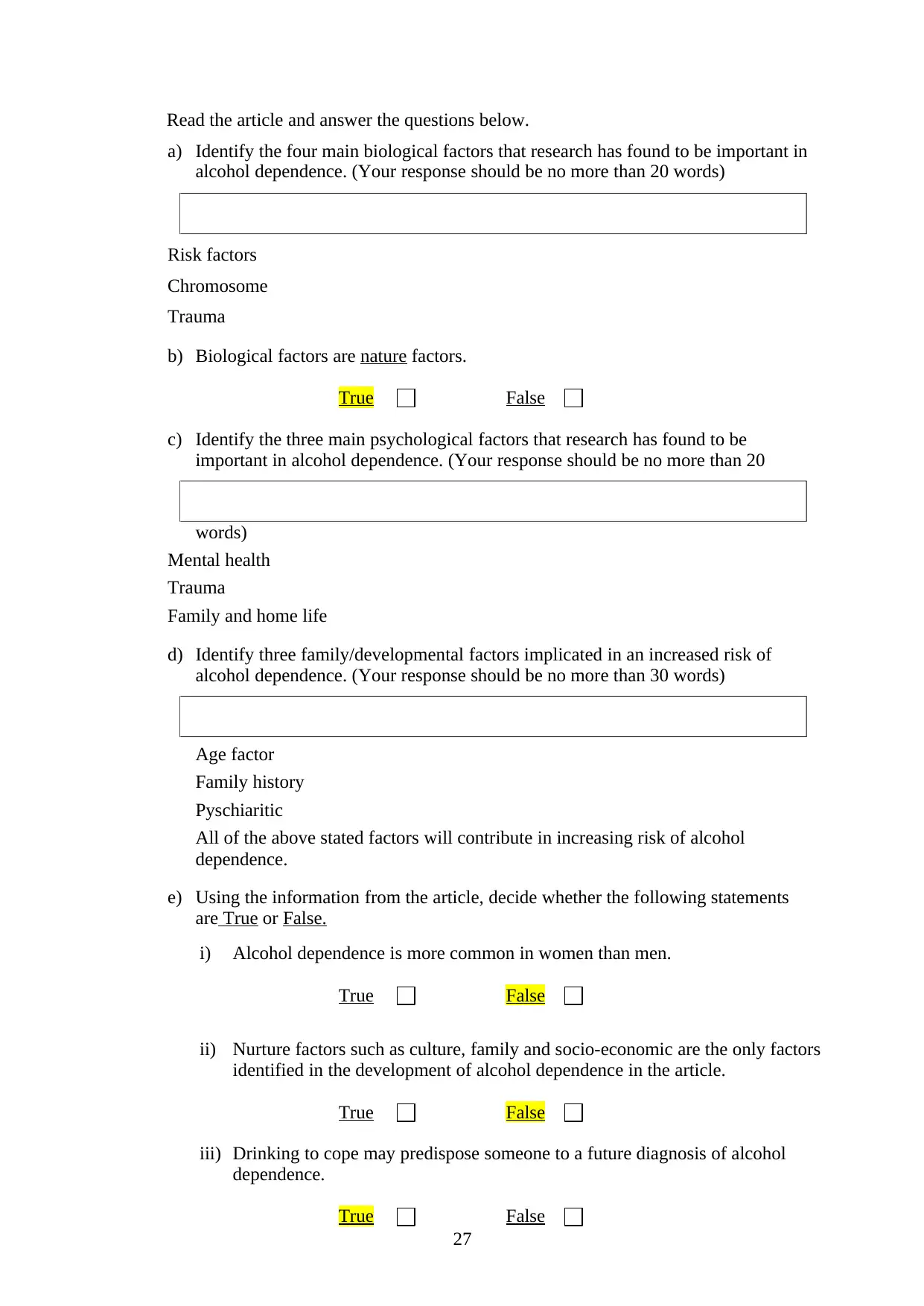
27
Read the article and answer the questions below.
a) Identify the four main biological factors that research has found to be important in
alcohol dependence. (Your response should be no more than 20 words)
Risk factors
Chromosome
Trauma
b) Biological factors are nature factors.
True False
c) Identify the three main psychological factors that research has found to be
important in alcohol dependence. (Your response should be no more than 20
words)
Mental health
Trauma
Family and home life
d) Identify three family/developmental factors implicated in an increased risk of
alcohol dependence. (Your response should be no more than 30 words)
Age factor
Family history
Pyschiaritic
All of the above stated factors will contribute in increasing risk of alcohol
dependence.
e) Using the information from the article, decide whether the following statements
are True or False.
i) Alcohol dependence is more common in women than men.
True False
ii) Nurture factors such as culture, family and socio-economic are the only factors
identified in the development of alcohol dependence in the article.
True False
iii) Drinking to cope may predispose someone to a future diagnosis of alcohol
dependence.
True False
Read the article and answer the questions below.
a) Identify the four main biological factors that research has found to be important in
alcohol dependence. (Your response should be no more than 20 words)
Risk factors
Chromosome
Trauma
b) Biological factors are nature factors.
True False
c) Identify the three main psychological factors that research has found to be
important in alcohol dependence. (Your response should be no more than 20
words)
Mental health
Trauma
Family and home life
d) Identify three family/developmental factors implicated in an increased risk of
alcohol dependence. (Your response should be no more than 30 words)
Age factor
Family history
Pyschiaritic
All of the above stated factors will contribute in increasing risk of alcohol
dependence.
e) Using the information from the article, decide whether the following statements
are True or False.
i) Alcohol dependence is more common in women than men.
True False
ii) Nurture factors such as culture, family and socio-economic are the only factors
identified in the development of alcohol dependence in the article.
True False
iii) Drinking to cope may predispose someone to a future diagnosis of alcohol
dependence.
True False
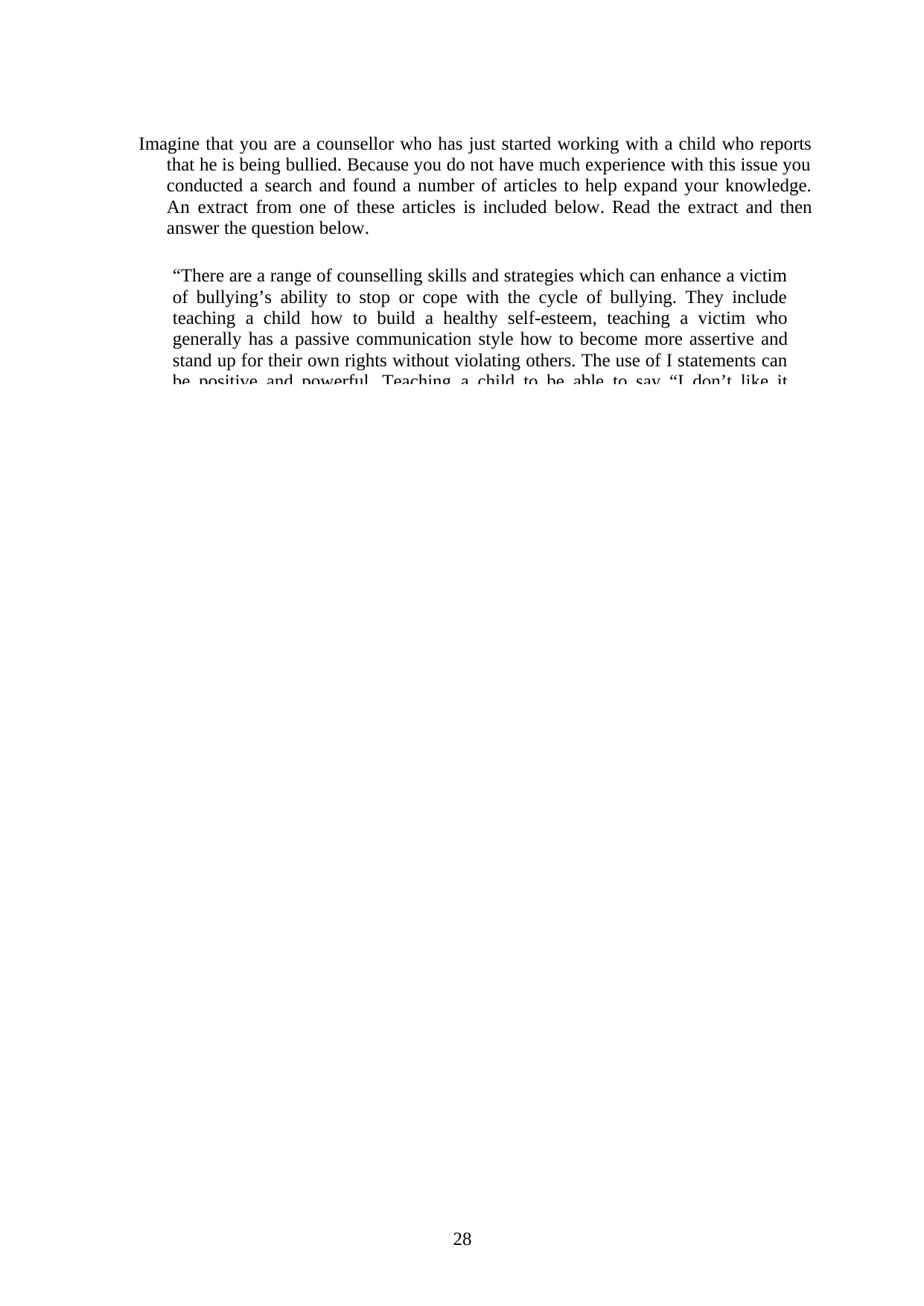
“There are a range of counselling skills and strategies which can enhance a victim
of bullying’s ability to stop or cope with the cycle of bullying. They include
teaching a child how to build a healthy self-esteem, teaching a victim who
generally has a passive communication style how to become more assertive and
stand up for their own rights without violating others. The use of I statements can
be positive and powerful. Teaching a child to be able to say “I don’t like it
28
Imagine that you are a counsellor who has just started working with a child who reports
that he is being bullied. Because you do not have much experience with this issue you
conducted a search and found a number of articles to help expand your knowledge.
An extract from one of these articles is included below. Read the extract and then
answer the question below.
of bullying’s ability to stop or cope with the cycle of bullying. They include
teaching a child how to build a healthy self-esteem, teaching a victim who
generally has a passive communication style how to become more assertive and
stand up for their own rights without violating others. The use of I statements can
be positive and powerful. Teaching a child to be able to say “I don’t like it
28
Imagine that you are a counsellor who has just started working with a child who reports
that he is being bullied. Because you do not have much experience with this issue you
conducted a search and found a number of articles to help expand your knowledge.
An extract from one of these articles is included below. Read the extract and then
answer the question below.
Secure Best Marks with AI Grader
Need help grading? Try our AI Grader for instant feedback on your assignments.

29
Conflict resolution skills are one of the more effective counselling techniques and
interventions a counsellor can apply in an effort to reduce victimisation. Conflict
resolution aims to create a win-win situation for everyone involved. By shifting
attention away from those involved and onto the problem, creative problem solving
can happen (Morrison, 2002). Teaching a child early on the skills of conflict
resolution will empower, prepare and support students to deal successfully with
conflict situations at school, at home and in later life. The range of conflict
resolution skills also includes effective listening, negotiation skills, assertiveness
skills training, problem solving and reflecting skills. Conflict resolution skills are
adaptable as they can be taught on an individual or group basis. More effectively
they can be introduced, developed and reinforced as ongoing components of the all-
curriculum areas (Morrison, 2002).
Check the level of a child’s self-esteem by asking them questions about “how they
see themselves”, what’s good and not so good about themselves?” It is important
that children have a positive self-concept and self-worth in order to confidently
apply conflict resolution skills. Confidence building strategies may, therefore, form
part of the intervention package for developing conflict resolution skills in children.
Encourage children to speak about their feelings openly and not to withdraw or
retreat as this may exacerbate feelings of sadness and isolation.
It is important that to assist a child’s understanding by utilising other therapy
techniques such as play therapy, sand tray, role play and drawing to facilitate self-
expression.
Involving parents in the counselling intervention: Parents are usually the first
people to notice the negative and dysfunctional changes in their children as a
response that their child is being bullied. As such, counsellors need to be aware that
they will be not only working with the child victim or bully but their concerned
parents. So, a counsellor will need to be able to impart skills training and
knowledge to both child and parent/s. Parents cannot ‘bully-proof’ a child.
However, the risk of their child being bullied can be reduced by parents who are
responsive to a child’s needs, employ an authoritative (not authoritarian) style of
parenting, have open communication, are involved in the child’s education and life
and encourage and teach their child to develop into a friendly and cooperative
individual. If bullying occurs it is best tackled collaboratively by parents,
counsellors and teachers working together.” (Clover, 1998).
Based upon what you have learned, list four counselling strategies that you could use
with your child client. (Your response should not be more than 75 words)
1. Communicate to the parents of child in order to develop detailed understanding on the overall client
case.
2. Make use of polite genuine communication skill for giving opportunity to child to get open in
appropriate manner.
3. Explain child how effectively therapy could support them in overcoming their problem.
4. Providing drawing material to child through which they can express their life situation.
Conflict resolution skills are one of the more effective counselling techniques and
interventions a counsellor can apply in an effort to reduce victimisation. Conflict
resolution aims to create a win-win situation for everyone involved. By shifting
attention away from those involved and onto the problem, creative problem solving
can happen (Morrison, 2002). Teaching a child early on the skills of conflict
resolution will empower, prepare and support students to deal successfully with
conflict situations at school, at home and in later life. The range of conflict
resolution skills also includes effective listening, negotiation skills, assertiveness
skills training, problem solving and reflecting skills. Conflict resolution skills are
adaptable as they can be taught on an individual or group basis. More effectively
they can be introduced, developed and reinforced as ongoing components of the all-
curriculum areas (Morrison, 2002).
Check the level of a child’s self-esteem by asking them questions about “how they
see themselves”, what’s good and not so good about themselves?” It is important
that children have a positive self-concept and self-worth in order to confidently
apply conflict resolution skills. Confidence building strategies may, therefore, form
part of the intervention package for developing conflict resolution skills in children.
Encourage children to speak about their feelings openly and not to withdraw or
retreat as this may exacerbate feelings of sadness and isolation.
It is important that to assist a child’s understanding by utilising other therapy
techniques such as play therapy, sand tray, role play and drawing to facilitate self-
expression.
Involving parents in the counselling intervention: Parents are usually the first
people to notice the negative and dysfunctional changes in their children as a
response that their child is being bullied. As such, counsellors need to be aware that
they will be not only working with the child victim or bully but their concerned
parents. So, a counsellor will need to be able to impart skills training and
knowledge to both child and parent/s. Parents cannot ‘bully-proof’ a child.
However, the risk of their child being bullied can be reduced by parents who are
responsive to a child’s needs, employ an authoritative (not authoritarian) style of
parenting, have open communication, are involved in the child’s education and life
and encourage and teach their child to develop into a friendly and cooperative
individual. If bullying occurs it is best tackled collaboratively by parents,
counsellors and teachers working together.” (Clover, 1998).
Based upon what you have learned, list four counselling strategies that you could use
with your child client. (Your response should not be more than 75 words)
1. Communicate to the parents of child in order to develop detailed understanding on the overall client
case.
2. Make use of polite genuine communication skill for giving opportunity to child to get open in
appropriate manner.
3. Explain child how effectively therapy could support them in overcoming their problem.
4. Providing drawing material to child through which they can express their life situation.
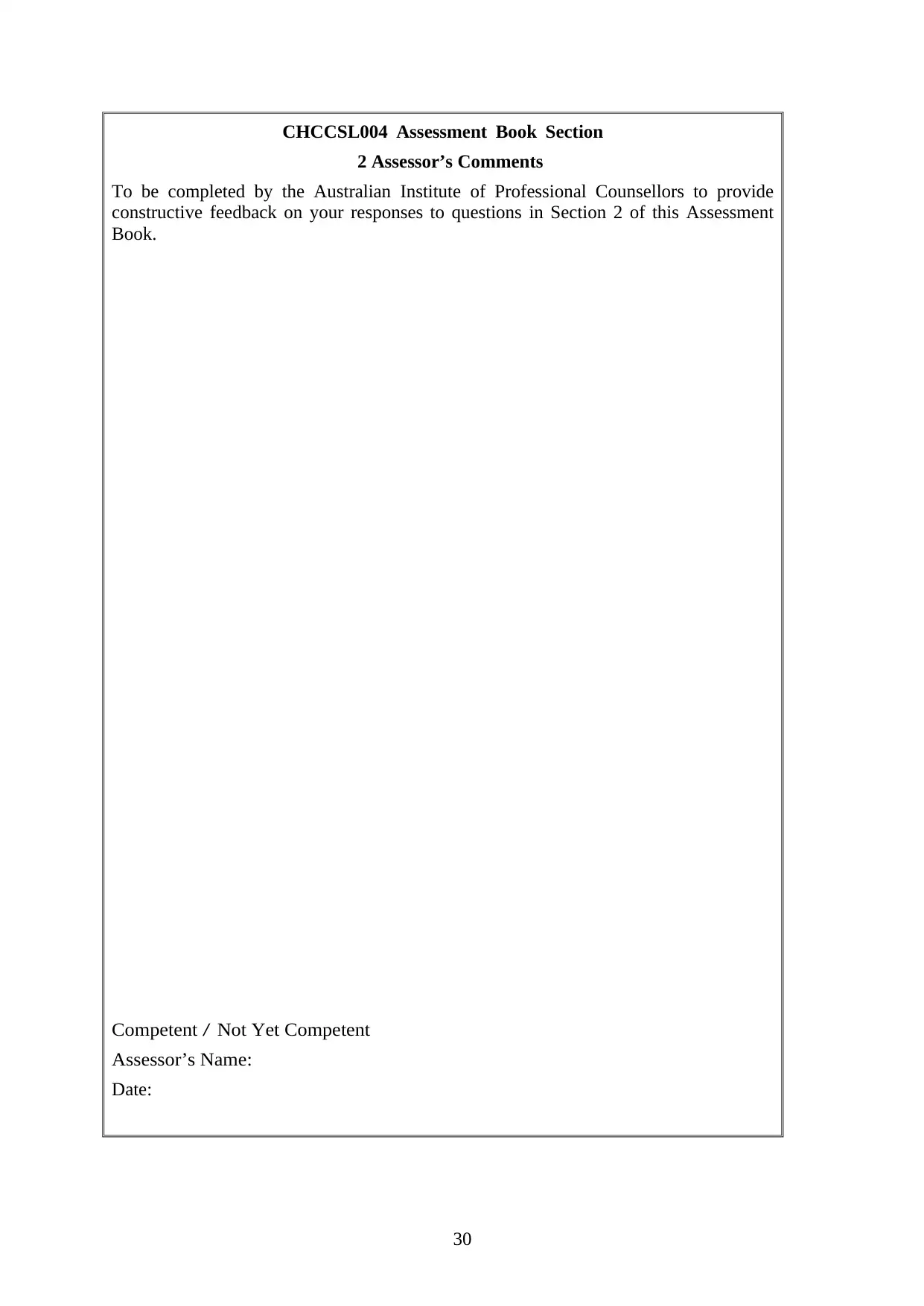
30
CHCCSL004 Assessment Book Section
2 Assessor’s Comments
To be completed by the Australian Institute of Professional Counsellors to provide
constructive feedback on your responses to questions in Section 2 of this Assessment
Book.
Competent / Not Yet Competent
Assessor’s Name:
Date:
CHCCSL004 Assessment Book Section
2 Assessor’s Comments
To be completed by the Australian Institute of Professional Counsellors to provide
constructive feedback on your responses to questions in Section 2 of this Assessment
Book.
Competent / Not Yet Competent
Assessor’s Name:
Date:
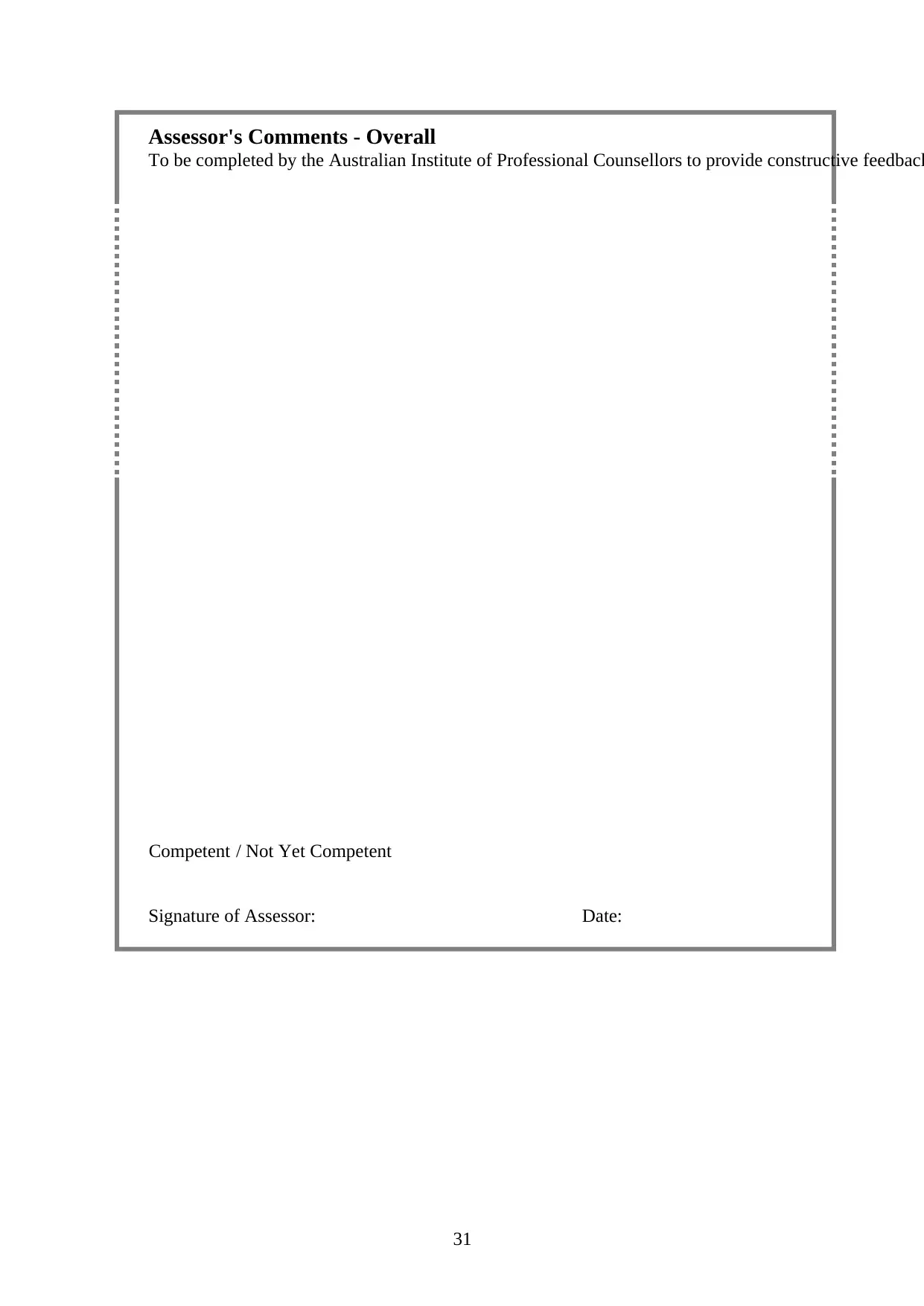
Assessor's Comments - Overall
To be completed by the Australian Institute of Professional Counsellors to provide constructive feedback
Competent / Not Yet Competent
Signature of Assessor: Date:
31
To be completed by the Australian Institute of Professional Counsellors to provide constructive feedback
Competent / Not Yet Competent
Signature of Assessor: Date:
31
Paraphrase This Document
Need a fresh take? Get an instant paraphrase of this document with our AI Paraphraser
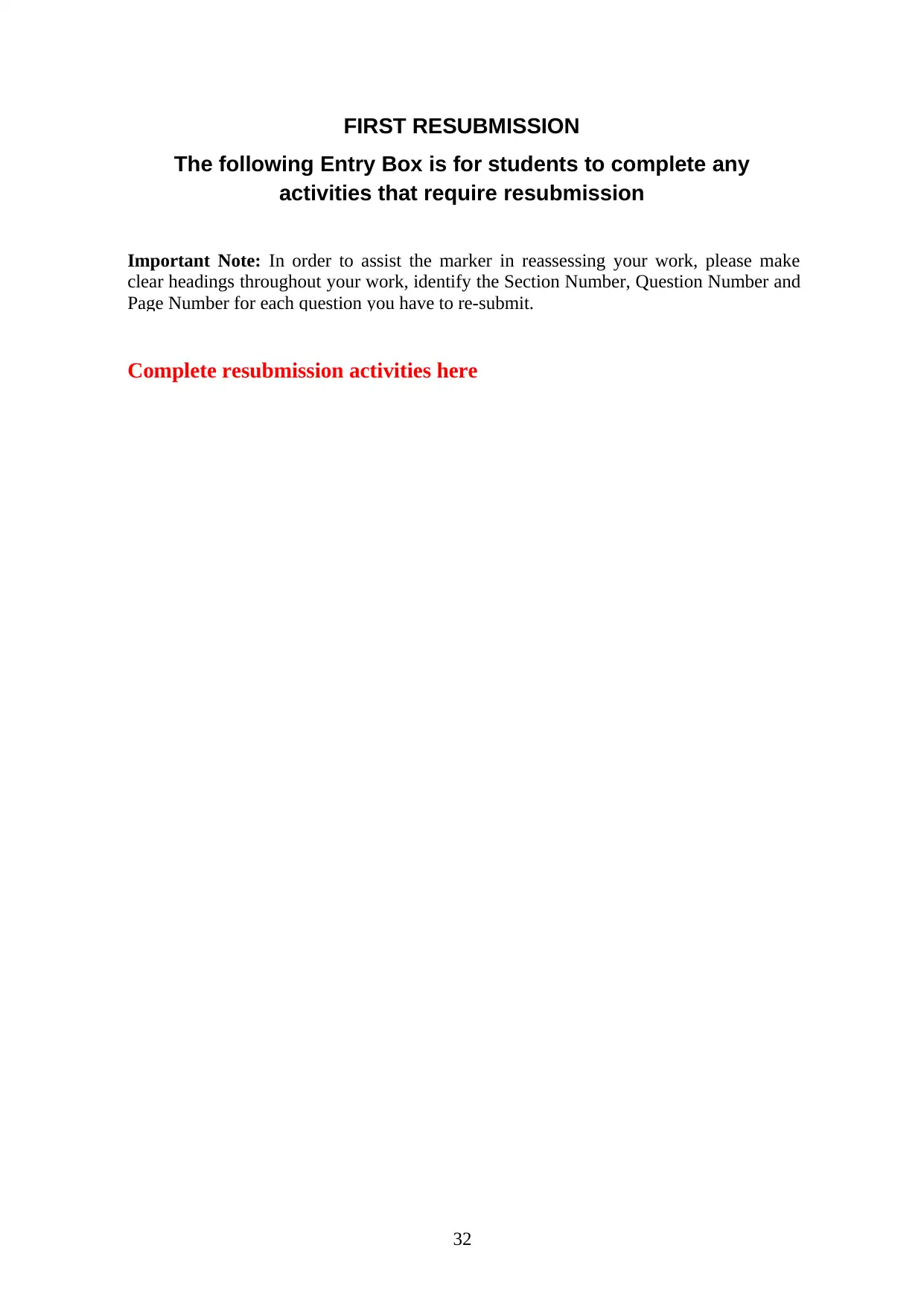
Important Note: In order to assist the marker in reassessing your work, please make
clear headings throughout your work, identify the Section Number, Question Number and
Page Number for each question you have to re-submit.
Complete resubmission activities here
32
FIRST RESUBMISSION
The following Entry Box is for students to complete any
activities that require resubmission
clear headings throughout your work, identify the Section Number, Question Number and
Page Number for each question you have to re-submit.
Complete resubmission activities here
32
FIRST RESUBMISSION
The following Entry Box is for students to complete any
activities that require resubmission
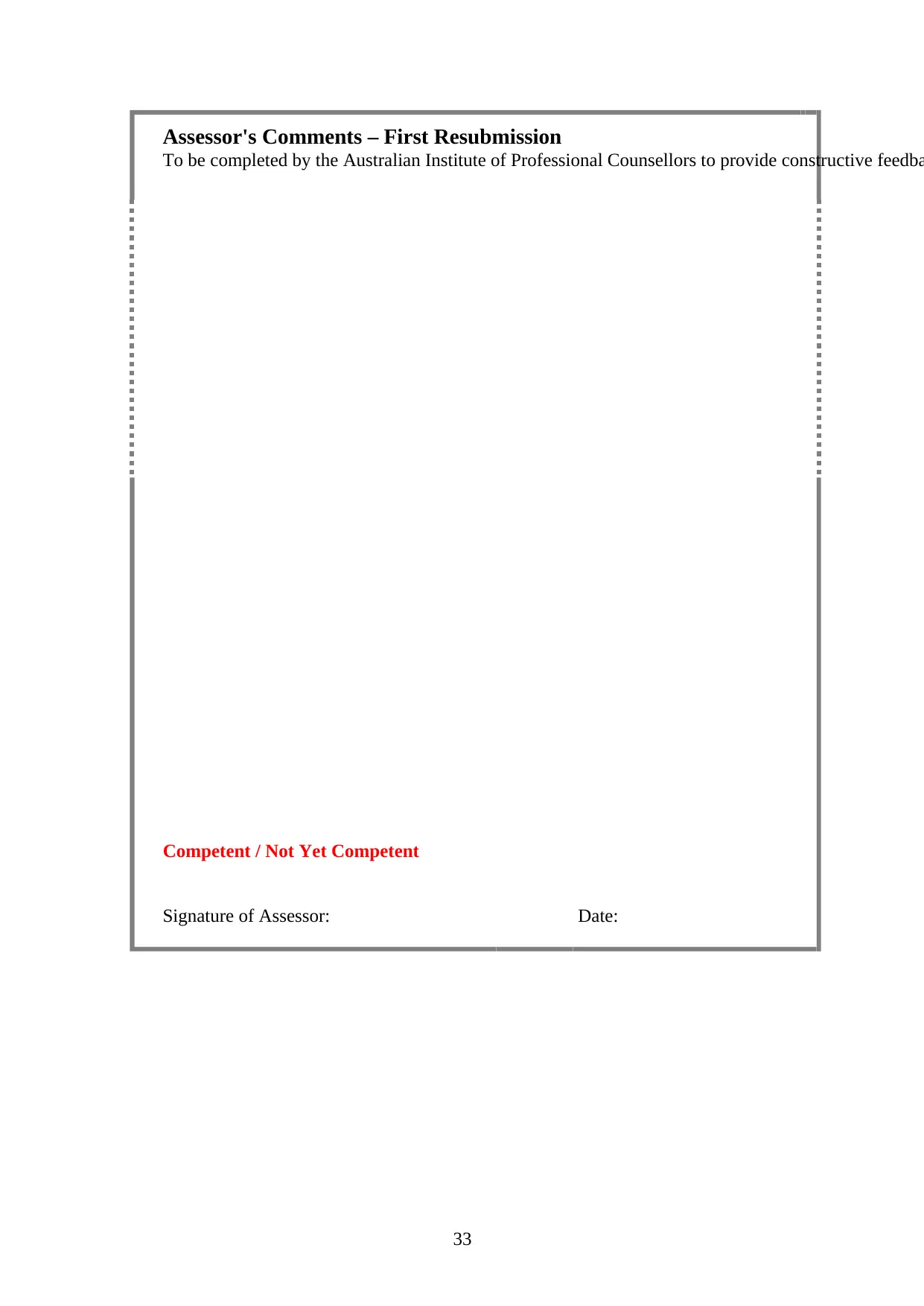
Assessor's Comments – First Resubmission
To be completed by the Australian Institute of Professional Counsellors to provide constructive feedba
Competent / Not Yet Competent
Signature of Assessor: Date:
33
To be completed by the Australian Institute of Professional Counsellors to provide constructive feedba
Competent / Not Yet Competent
Signature of Assessor: Date:
33

Important Note: In order to assist the marker in reassessing your work, please make
clear headings throughout your work, identify the Section Number, Question Number
and Page Number for each question you have to re-submit.
Complete second resubmission activities here
34
SECOND RESUBMISSION
The following Entry Box is for students to complete any
activities that require resubmission
clear headings throughout your work, identify the Section Number, Question Number
and Page Number for each question you have to re-submit.
Complete second resubmission activities here
34
SECOND RESUBMISSION
The following Entry Box is for students to complete any
activities that require resubmission
Secure Best Marks with AI Grader
Need help grading? Try our AI Grader for instant feedback on your assignments.
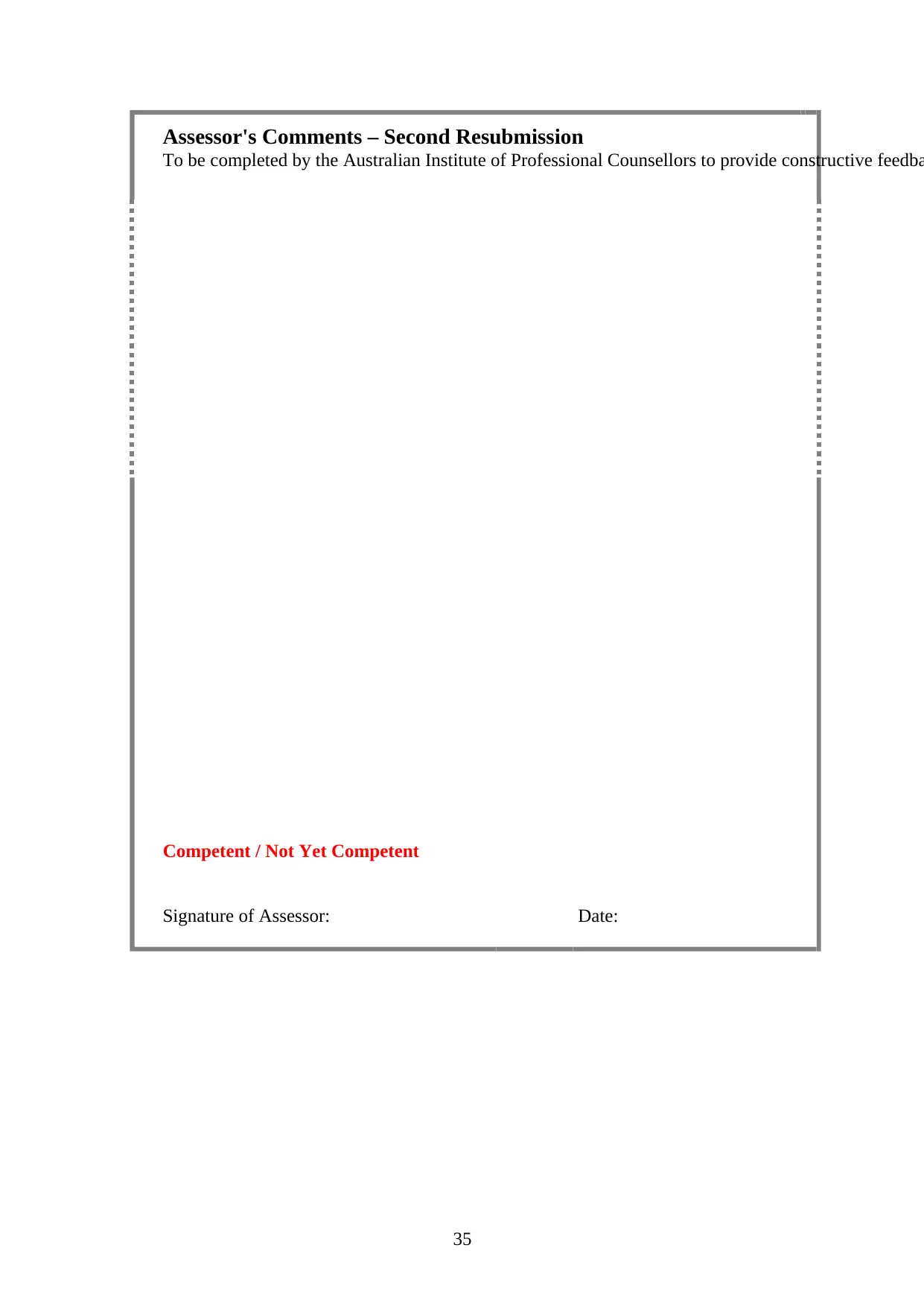
Assessor's Comments – Second Resubmission
To be completed by the Australian Institute of Professional Counsellors to provide constructive feedba
Competent / Not Yet Competent
Signature of Assessor: Date:
35
To be completed by the Australian Institute of Professional Counsellors to provide constructive feedba
Competent / Not Yet Competent
Signature of Assessor: Date:
35
1 out of 35
Related Documents
Your All-in-One AI-Powered Toolkit for Academic Success.
+13062052269
info@desklib.com
Available 24*7 on WhatsApp / Email
![[object Object]](/_next/static/media/star-bottom.7253800d.svg)
Unlock your academic potential
© 2024 | Zucol Services PVT LTD | All rights reserved.





